Strength Improvement of GGBS Concrete
VerifiedAdded on 2023/01/12
|35
|9558
|82
AI Summary
This study evaluates the strength improvement of GGBS concrete under normal curing conditions and its benefits in terms of environmental friendliness, durability, and economic sustainability.
Contribute Materials
Your contribution can guide someone’s learning journey. Share your
documents today.

REPORT
Secure Best Marks with AI Grader
Need help grading? Try our AI Grader for instant feedback on your assignments.
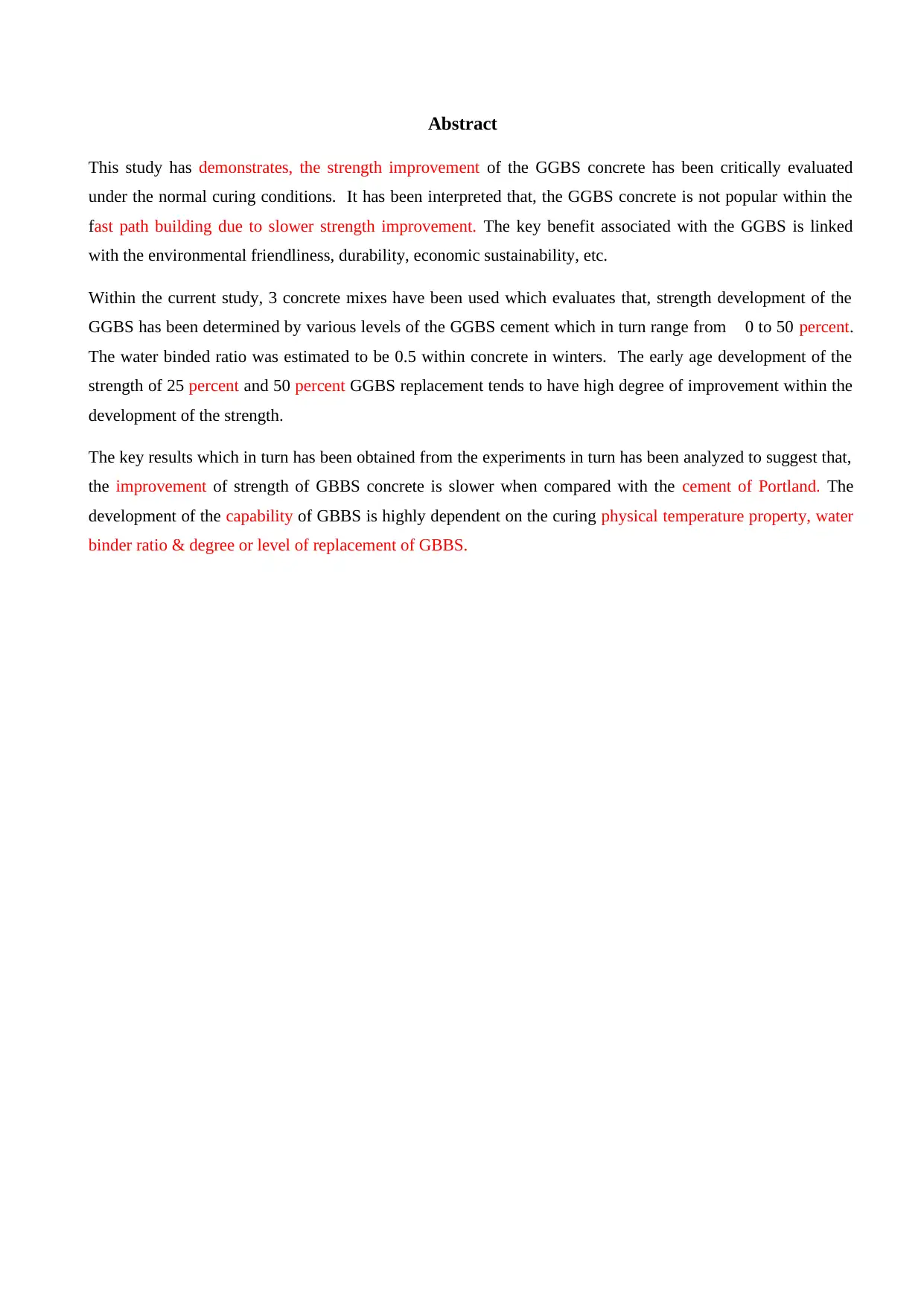
Abstract
This study has demonstrates, the strength improvement of the GGBS concrete has been critically evaluated
under the normal curing conditions. It has been interpreted that, the GGBS concrete is not popular within the
fast path building due to slower strength improvement. The key benefit associated with the GGBS is linked
with the environmental friendliness, durability, economic sustainability, etc.
Within the current study, 3 concrete mixes have been used which evaluates that, strength development of the
GGBS has been determined by various levels of the GGBS cement which in turn range from 0 to 50 percent.
The water binded ratio was estimated to be 0.5 within concrete in winters. The early age development of the
strength of 25 percent and 50 percent GGBS replacement tends to have high degree of improvement within the
development of the strength.
The key results which in turn has been obtained from the experiments in turn has been analyzed to suggest that,
the improvement of strength of GBBS concrete is slower when compared with the cement of Portland. The
development of the capability of GBBS is highly dependent on the curing physical temperature property, water
binder ratio & degree or level of replacement of GBBS.
This study has demonstrates, the strength improvement of the GGBS concrete has been critically evaluated
under the normal curing conditions. It has been interpreted that, the GGBS concrete is not popular within the
fast path building due to slower strength improvement. The key benefit associated with the GGBS is linked
with the environmental friendliness, durability, economic sustainability, etc.
Within the current study, 3 concrete mixes have been used which evaluates that, strength development of the
GGBS has been determined by various levels of the GGBS cement which in turn range from 0 to 50 percent.
The water binded ratio was estimated to be 0.5 within concrete in winters. The early age development of the
strength of 25 percent and 50 percent GGBS replacement tends to have high degree of improvement within the
development of the strength.
The key results which in turn has been obtained from the experiments in turn has been analyzed to suggest that,
the improvement of strength of GBBS concrete is slower when compared with the cement of Portland. The
development of the capability of GBBS is highly dependent on the curing physical temperature property, water
binder ratio & degree or level of replacement of GBBS.

Contents
Abstract................................................................................................................................................2
CHAPTER 1: INTRODUCTION........................................................................................................4
Chapter 2: Literature review.................................................................................................................5
2.1 Historical use of GGBS........................................................................................................5
2.2 The effect of GGBS on the durability of Concrete...............................................................6
2.2.1 Premeability.......................................................................................................................6
2.2.2 Carbonation........................................................................................................................6
2.2.3 Suplhate resistance............................................................................................................7
2.2.4 Chloride.............................................................................................................................7
2.3 the effects of GGBS upon physical properties of Concrete..................................................7
2.4 GGBS effect on chemical Properties of concrete:................................................................8
..............................................................................................................................................................9
CHAPTER 3: MATERIALS AND METHODS................................................................................15
Concrete Casting and Curing:............................................................................................................18
3.2.6 Testing, procedures and equipment:..........................................................................................19
Equipment’s:......................................................................................................................................20
Equipment’s:......................................................................................................................................21
CHAPTER 4: RESULTS AND DISCUSSION.................................................................................22
CHAPTER 5: CONCLUSIONS.........................................................................................................27
Chapter 6: Recommendation for carrying out future study................................................................28
REFERENCES...................................................................................................................................30
CHAPTER 8 APPENDENCES..........................................................................................................34
Abstract................................................................................................................................................2
CHAPTER 1: INTRODUCTION........................................................................................................4
Chapter 2: Literature review.................................................................................................................5
2.1 Historical use of GGBS........................................................................................................5
2.2 The effect of GGBS on the durability of Concrete...............................................................6
2.2.1 Premeability.......................................................................................................................6
2.2.2 Carbonation........................................................................................................................6
2.2.3 Suplhate resistance............................................................................................................7
2.2.4 Chloride.............................................................................................................................7
2.3 the effects of GGBS upon physical properties of Concrete..................................................7
2.4 GGBS effect on chemical Properties of concrete:................................................................8
..............................................................................................................................................................9
CHAPTER 3: MATERIALS AND METHODS................................................................................15
Concrete Casting and Curing:............................................................................................................18
3.2.6 Testing, procedures and equipment:..........................................................................................19
Equipment’s:......................................................................................................................................20
Equipment’s:......................................................................................................................................21
CHAPTER 4: RESULTS AND DISCUSSION.................................................................................22
CHAPTER 5: CONCLUSIONS.........................................................................................................27
Chapter 6: Recommendation for carrying out future study................................................................28
REFERENCES...................................................................................................................................30
CHAPTER 8 APPENDENCES..........................................................................................................34

CHAPTER 1: INTRODUCTION
1.1 Background Info: Utilization of the material recycled within the products of the building is considered to
be very crucial for sustainable growth. It has been established that, concrete is used at a large scale within the
construction industry. One of the key fundamental part associated with the concrete is to effectively focus on
the production of Portland cement which in turn largely contributes towards the emission of the carbon dioxide
and generation of greenhouse gases. Manufacturing of 1 T of Portland cement tends to create 1 T of carbon
dioxide and various set of green house gasses such as GHG’s (Abutaha, Abdul Razak and Ibrahim, 2017)
Effectively utilizing the waste materials within the production of the construction material is very useful in
increasing the sustainablity of the building which in turn tends to provide environmental and economical
benefits. GGBS referred to as the GGBS is reasoned to be one of the by- products that is useful in development
of the sustainable building.
Al-Oran, Safiee and Nasir, (2019) established the fact that, GGBS is a by-product which is manufactured
within the iron industry. Here, iron ore, limestone and coke are used into the furnace within the temperature
which ranges from 1500 degree Celsius to 1800 degree Celsius. Where elements such as other gases and water
have an effective route in order to escape by leaving the molten iron right in the bottom and molten slag
floatation where they have been separated. Dimov and et.al., (2018), additional set of energy is required for
the production of GGBS when compared with the amount of energy which in turn is required for the
manufacturing of the Portland cement (Granulated Blast-Furnace Slag (GBS), 2020). Replacing Portland
cement with the GGBS will eventually results in lower emission of the carbon dioxide. Hence GGBS is
considered to be one of the environmental friendly material for the construction.
GGBS is effectively used in order to replace 80 percent of Portland cement which has been used in the
concrete. GGBS is an effective concrete which in turn has an effective water impermeability characteristics and
also has improved sulphate attack and improved resistance to the corrosion. This way it helps in enhancing the
life of the building and also reduced maintenance cost (Huang And et.al., 2016). Use of the sustainable
material is way to common for the sustainable construction. GGBS tends to have high degree of sustainable
advantages at the time of using GGBS. This in turn involves high degree of long term strength associated with
the concrete in order to attain improved workability and durability. GGBS also tends to have high degree of
economic benefits which is cheaper than the Portland cement. It is also very useful in reducing the emission of
the carbon dioxide in comparison with the Portland cement. One of the key disadvantage associated with the
GGBS is that, it results in slow strength development at the time of low temperature such as winter. Hence,
GGBS is not used within the fast track construction. On the contrary, at the time of high temperature the early
strength also enhances.
Research Question: To critically identify key existing waste materials and also discuss the material with
its specific properties. This study will also determine the use of waste material in concrete and also to
1.1 Background Info: Utilization of the material recycled within the products of the building is considered to
be very crucial for sustainable growth. It has been established that, concrete is used at a large scale within the
construction industry. One of the key fundamental part associated with the concrete is to effectively focus on
the production of Portland cement which in turn largely contributes towards the emission of the carbon dioxide
and generation of greenhouse gases. Manufacturing of 1 T of Portland cement tends to create 1 T of carbon
dioxide and various set of green house gasses such as GHG’s (Abutaha, Abdul Razak and Ibrahim, 2017)
Effectively utilizing the waste materials within the production of the construction material is very useful in
increasing the sustainablity of the building which in turn tends to provide environmental and economical
benefits. GGBS referred to as the GGBS is reasoned to be one of the by- products that is useful in development
of the sustainable building.
Al-Oran, Safiee and Nasir, (2019) established the fact that, GGBS is a by-product which is manufactured
within the iron industry. Here, iron ore, limestone and coke are used into the furnace within the temperature
which ranges from 1500 degree Celsius to 1800 degree Celsius. Where elements such as other gases and water
have an effective route in order to escape by leaving the molten iron right in the bottom and molten slag
floatation where they have been separated. Dimov and et.al., (2018), additional set of energy is required for
the production of GGBS when compared with the amount of energy which in turn is required for the
manufacturing of the Portland cement (Granulated Blast-Furnace Slag (GBS), 2020). Replacing Portland
cement with the GGBS will eventually results in lower emission of the carbon dioxide. Hence GGBS is
considered to be one of the environmental friendly material for the construction.
GGBS is effectively used in order to replace 80 percent of Portland cement which has been used in the
concrete. GGBS is an effective concrete which in turn has an effective water impermeability characteristics and
also has improved sulphate attack and improved resistance to the corrosion. This way it helps in enhancing the
life of the building and also reduced maintenance cost (Huang And et.al., 2016). Use of the sustainable
material is way to common for the sustainable construction. GGBS tends to have high degree of sustainable
advantages at the time of using GGBS. This in turn involves high degree of long term strength associated with
the concrete in order to attain improved workability and durability. GGBS also tends to have high degree of
economic benefits which is cheaper than the Portland cement. It is also very useful in reducing the emission of
the carbon dioxide in comparison with the Portland cement. One of the key disadvantage associated with the
GGBS is that, it results in slow strength development at the time of low temperature such as winter. Hence,
GGBS is not used within the fast track construction. On the contrary, at the time of high temperature the early
strength also enhances.
Research Question: To critically identify key existing waste materials and also discuss the material with
its specific properties. This study will also determine the use of waste material in concrete and also to
Secure Best Marks with AI Grader
Need help grading? Try our AI Grader for instant feedback on your assignments.

compare with the managed mixed design concrete.
Aim: To evaluate on the strength development of the concrete which has been made with the GGBS
as replacement of cement.
Objectives: With the aim to attain the specific target, the key objectives for this has been set:
To study the existing literature which is based on usage of the surplus material for cement.
To develop critical understanding on the British standards for costing, testing, curative and producing
techniques for hardened and fresh concrete things.
Setting up the protocol for carrying out research protocol of various percent of aggregate replacement
and cement.
To assess the strength improvement of the concrete and in turn also run complete enquiry of the
outcomes associated with the strength.
In order to draw valid summary on the key prospect for utilizing waste provisions for the manufacture
of concrete.
Chapter 2: Literature review
2.1 Historic utilization of GGBS
GGBS was first revealed in 1862 by Emil Langin, but it cannot be recognized as a new sustainability
material. Also, the material was first used in Germany by 1880 with Portland Cement, while on the other side,
Europe also use the same from last 100 years and even Paris metro was also constructed in 1889.
Further, GGBS was also formulated abroad and it was also initiate in UK from last many century ago
but there was no importance from recent years. There are many reason of using such material i.e. the
accessibility of tremendous measure of raw material which are used for manufacture of Portland cement.
(Yeung, Yam and Wong, 2019) Also, the research shows that GGBS is also used for through the world war
one in 1930 by an iron and steel commercial enterprise investigation council. Beside this, when building taken
place in sea, at that time, the lastingness of strengthened factual was also recorded effective as compared to use
of Portland cement. In the same time, a single case study shows that the introduction of GGBS is only a sign of
usage 33000 tonnes of GGBBS for a build a Humber Bridge in England on 1972.
While on the other side, in Britain GGBS is actually utilized from last 2 million tonnes all period and it
has been used by institution who use cement and concrete crosswise Europe landmass where around 17.7
million tonnes are already in use. Moreover, supply of GGBS is also available in North of England at 1982 and
it was also accessible in South of England by beginning of GGBS maker on river Thames. Thus, the
consumption of GGBS is varies from different area to area, such that the use of GGBS is about 20 percent only
Aim: To evaluate on the strength development of the concrete which has been made with the GGBS
as replacement of cement.
Objectives: With the aim to attain the specific target, the key objectives for this has been set:
To study the existing literature which is based on usage of the surplus material for cement.
To develop critical understanding on the British standards for costing, testing, curative and producing
techniques for hardened and fresh concrete things.
Setting up the protocol for carrying out research protocol of various percent of aggregate replacement
and cement.
To assess the strength improvement of the concrete and in turn also run complete enquiry of the
outcomes associated with the strength.
In order to draw valid summary on the key prospect for utilizing waste provisions for the manufacture
of concrete.
Chapter 2: Literature review
2.1 Historic utilization of GGBS
GGBS was first revealed in 1862 by Emil Langin, but it cannot be recognized as a new sustainability
material. Also, the material was first used in Germany by 1880 with Portland Cement, while on the other side,
Europe also use the same from last 100 years and even Paris metro was also constructed in 1889.
Further, GGBS was also formulated abroad and it was also initiate in UK from last many century ago
but there was no importance from recent years. There are many reason of using such material i.e. the
accessibility of tremendous measure of raw material which are used for manufacture of Portland cement.
(Yeung, Yam and Wong, 2019) Also, the research shows that GGBS is also used for through the world war
one in 1930 by an iron and steel commercial enterprise investigation council. Beside this, when building taken
place in sea, at that time, the lastingness of strengthened factual was also recorded effective as compared to use
of Portland cement. In the same time, a single case study shows that the introduction of GGBS is only a sign of
usage 33000 tonnes of GGBBS for a build a Humber Bridge in England on 1972.
While on the other side, in Britain GGBS is actually utilized from last 2 million tonnes all period and it
has been used by institution who use cement and concrete crosswise Europe landmass where around 17.7
million tonnes are already in use. Moreover, supply of GGBS is also available in North of England at 1982 and
it was also accessible in South of England by beginning of GGBS maker on river Thames. Thus, the
consumption of GGBS is varies from different area to area, such that the use of GGBS is about 20 percent only

in Western Europe along with Netherlands is 60 percent. thus, it reflect that it is varies from area to area
(Samson, Cyr and Gao, 2017). While, America is uses this from last or more than 50 years and research also
state that there are around 40 percent replacement has been done of Portland cement, but it is further
multifaceted in other project I,e, Minneapolis Airport where around 35 percent of cement is used, also in metro
airport terminal expansion around 30 percent of the GGBS is used. Further, the study promulgated by concrete
society working party in 2011, it was stated that around 2 million tonnes of GGBS is uses in UK in the form of
primed mix, collection and formed objective.
2.2 The effect of GGBS on the durability of Concrete
Research display that the utilisation of GGBS assist to gain the lastingness of concrete such that
2.2.1 Premeability
Hawileh and et.al., (2017) stated that GGBS has a devalued porosity because it has low chloride
incursion which actually amend the opposition alkali silica as compared to Portland Cement Concrete. In the
same way. Tavasoli, Nili and Serpoush (2018) also stated that porosity of concrete is actually depend upon
the grade of association , so the porousness of 2 days healed GGBS concrete which is higher than Portland
cement concrete while on the other side, when it is used with another then it decrease immediately. Rao,
Sravana and Rao (2016) also present their views that when there is extent of 20 mm to 40 mm of chapped
GGBS concrete and at that time, the rate of deterioration of steel is reduce up to 40 percent as comparison to
Portland cement.
In the opinion of Jawahar and Mounika (2016) use of GGBS cut down the permeableness in
concrete because if the decrease of porousness that also impact major aspect of lastingness of concrete because
it is mainly against the corrosion as well as Sulphate attack
2.2.2 Carbonation
There are so many research conduct on GGBS of carbonation such that Singh, Kushwaha and
Thomas (2019) suggest that when GGBS is added in concrete then it lessening the extent of carbonation
immediately. In the same time, Yeung, Yam and Wong (2019) also noted that it is not a chief cause in rate of
permeation in objective and it is so because they only found up to 3 to 4 mm addition in extent of carbonation
as comparison to Portland cement. On contrary, Saranya, Nagarajan and Shashikala (2020) argued that due
to Pozzolanic reactivity, the precise atom of GGBS actually take away the spread between concrete atom and
also, the depth of carbonation from 7, 28, 56 days of a example. Thus, it makes concrete more denser because it
actually reduce carbon dioxide in order to enter to concrete and therefore, carbonation is also improve that
further leads to increase depth of carbonation.
2.2.3 Suplhate resistance
In order to gain the opposition, as compared to Sulphate attack the GGBS concrete is actually calculate
(Samson, Cyr and Gao, 2017). While, America is uses this from last or more than 50 years and research also
state that there are around 40 percent replacement has been done of Portland cement, but it is further
multifaceted in other project I,e, Minneapolis Airport where around 35 percent of cement is used, also in metro
airport terminal expansion around 30 percent of the GGBS is used. Further, the study promulgated by concrete
society working party in 2011, it was stated that around 2 million tonnes of GGBS is uses in UK in the form of
primed mix, collection and formed objective.
2.2 The effect of GGBS on the durability of Concrete
Research display that the utilisation of GGBS assist to gain the lastingness of concrete such that
2.2.1 Premeability
Hawileh and et.al., (2017) stated that GGBS has a devalued porosity because it has low chloride
incursion which actually amend the opposition alkali silica as compared to Portland Cement Concrete. In the
same way. Tavasoli, Nili and Serpoush (2018) also stated that porosity of concrete is actually depend upon
the grade of association , so the porousness of 2 days healed GGBS concrete which is higher than Portland
cement concrete while on the other side, when it is used with another then it decrease immediately. Rao,
Sravana and Rao (2016) also present their views that when there is extent of 20 mm to 40 mm of chapped
GGBS concrete and at that time, the rate of deterioration of steel is reduce up to 40 percent as comparison to
Portland cement.
In the opinion of Jawahar and Mounika (2016) use of GGBS cut down the permeableness in
concrete because if the decrease of porousness that also impact major aspect of lastingness of concrete because
it is mainly against the corrosion as well as Sulphate attack
2.2.2 Carbonation
There are so many research conduct on GGBS of carbonation such that Singh, Kushwaha and
Thomas (2019) suggest that when GGBS is added in concrete then it lessening the extent of carbonation
immediately. In the same time, Yeung, Yam and Wong (2019) also noted that it is not a chief cause in rate of
permeation in objective and it is so because they only found up to 3 to 4 mm addition in extent of carbonation
as comparison to Portland cement. On contrary, Saranya, Nagarajan and Shashikala (2020) argued that due
to Pozzolanic reactivity, the precise atom of GGBS actually take away the spread between concrete atom and
also, the depth of carbonation from 7, 28, 56 days of a example. Thus, it makes concrete more denser because it
actually reduce carbon dioxide in order to enter to concrete and therefore, carbonation is also improve that
further leads to increase depth of carbonation.
2.2.3 Suplhate resistance
In order to gain the opposition, as compared to Sulphate attack the GGBS concrete is actually calculate
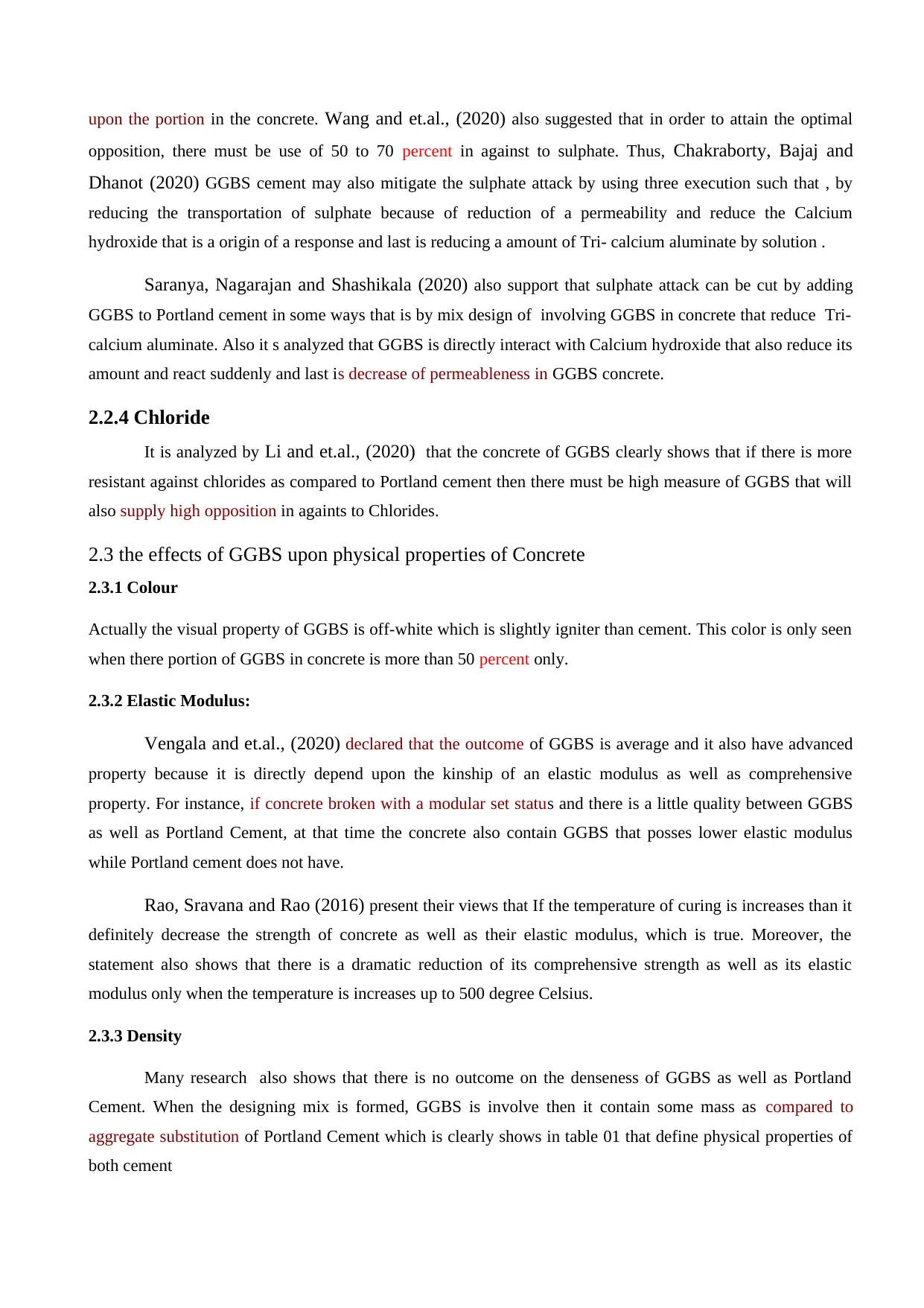
upon the portion in the concrete. Wang and et.al., (2020) also suggested that in order to attain the optimal
opposition, there must be use of 50 to 70 percent in against to sulphate. Thus, Chakraborty, Bajaj and
Dhanot (2020) GGBS cement may also mitigate the sulphate attack by using three execution such that , by
reducing the transportation of sulphate because of reduction of a permeability and reduce the Calcium
hydroxide that is a origin of a response and last is reducing a amount of Tri- calcium aluminate by solution .
Saranya, Nagarajan and Shashikala (2020) also support that sulphate attack can be cut by adding
GGBS to Portland cement in some ways that is by mix design of involving GGBS in concrete that reduce Tri-
calcium aluminate. Also it s analyzed that GGBS is directly interact with Calcium hydroxide that also reduce its
amount and react suddenly and last is decrease of permeableness in GGBS concrete.
2.2.4 Chloride
It is analyzed by Li and et.al., (2020) that the concrete of GGBS clearly shows that if there is more
resistant against chlorides as compared to Portland cement then there must be high measure of GGBS that will
also supply high opposition in againts to Chlorides.
2.3 the effects of GGBS upon physical properties of Concrete
2.3.1 Colour
Actually the visual property of GGBS is off-white which is slightly igniter than cement. This color is only seen
when there portion of GGBS in concrete is more than 50 percent only.
2.3.2 Elastic Modulus:
Vengala and et.al., (2020) declared that the outcome of GGBS is average and it also have advanced
property because it is directly depend upon the kinship of an elastic modulus as well as comprehensive
property. For instance, if concrete broken with a modular set status and there is a little quality between GGBS
as well as Portland Cement, at that time the concrete also contain GGBS that posses lower elastic modulus
while Portland cement does not have.
Rao, Sravana and Rao (2016) present their views that If the temperature of curing is increases than it
definitely decrease the strength of concrete as well as their elastic modulus, which is true. Moreover, the
statement also shows that there is a dramatic reduction of its comprehensive strength as well as its elastic
modulus only when the temperature is increases up to 500 degree Celsius.
2.3.3 Density
Many research also shows that there is no outcome on the denseness of GGBS as well as Portland
Cement. When the designing mix is formed, GGBS is involve then it contain some mass as compared to
aggregate substitution of Portland Cement which is clearly shows in table 01 that define physical properties of
both cement
opposition, there must be use of 50 to 70 percent in against to sulphate. Thus, Chakraborty, Bajaj and
Dhanot (2020) GGBS cement may also mitigate the sulphate attack by using three execution such that , by
reducing the transportation of sulphate because of reduction of a permeability and reduce the Calcium
hydroxide that is a origin of a response and last is reducing a amount of Tri- calcium aluminate by solution .
Saranya, Nagarajan and Shashikala (2020) also support that sulphate attack can be cut by adding
GGBS to Portland cement in some ways that is by mix design of involving GGBS in concrete that reduce Tri-
calcium aluminate. Also it s analyzed that GGBS is directly interact with Calcium hydroxide that also reduce its
amount and react suddenly and last is decrease of permeableness in GGBS concrete.
2.2.4 Chloride
It is analyzed by Li and et.al., (2020) that the concrete of GGBS clearly shows that if there is more
resistant against chlorides as compared to Portland cement then there must be high measure of GGBS that will
also supply high opposition in againts to Chlorides.
2.3 the effects of GGBS upon physical properties of Concrete
2.3.1 Colour
Actually the visual property of GGBS is off-white which is slightly igniter than cement. This color is only seen
when there portion of GGBS in concrete is more than 50 percent only.
2.3.2 Elastic Modulus:
Vengala and et.al., (2020) declared that the outcome of GGBS is average and it also have advanced
property because it is directly depend upon the kinship of an elastic modulus as well as comprehensive
property. For instance, if concrete broken with a modular set status and there is a little quality between GGBS
as well as Portland Cement, at that time the concrete also contain GGBS that posses lower elastic modulus
while Portland cement does not have.
Rao, Sravana and Rao (2016) present their views that If the temperature of curing is increases than it
definitely decrease the strength of concrete as well as their elastic modulus, which is true. Moreover, the
statement also shows that there is a dramatic reduction of its comprehensive strength as well as its elastic
modulus only when the temperature is increases up to 500 degree Celsius.
2.3.3 Density
Many research also shows that there is no outcome on the denseness of GGBS as well as Portland
Cement. When the designing mix is formed, GGBS is involve then it contain some mass as compared to
aggregate substitution of Portland Cement which is clearly shows in table 01 that define physical properties of
both cement
Paraphrase This Document
Need a fresh take? Get an instant paraphrase of this document with our AI Paraphraser
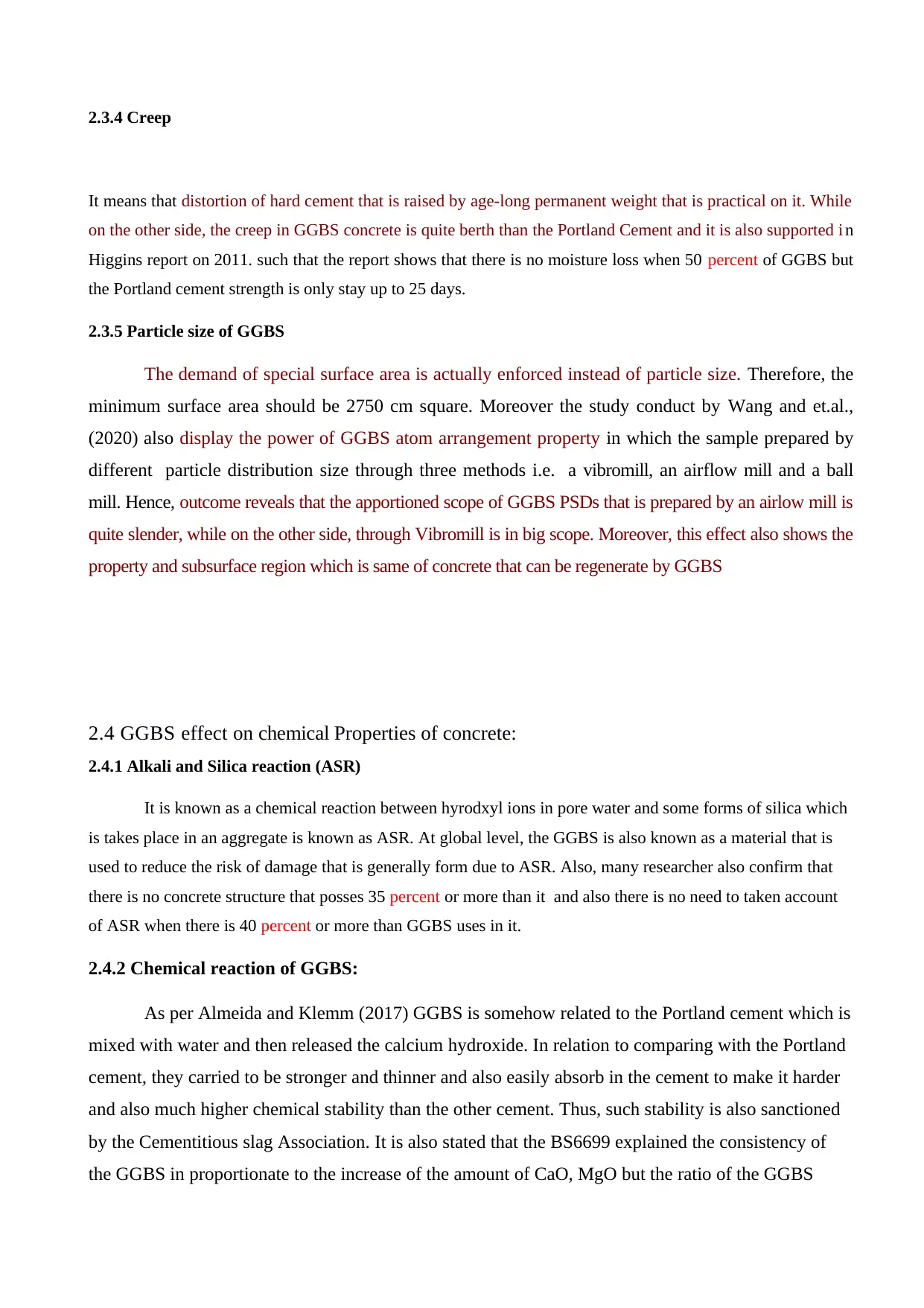
2.3.4 Creep
It means that distortion of hard cement that is raised by age-long permanent weight that is practical on it. While
on the other side, the creep in GGBS concrete is quite berth than the Portland Cement and it is also supported i n
Higgins report on 2011. such that the report shows that there is no moisture loss when 50 percent of GGBS but
the Portland cement strength is only stay up to 25 days.
2.3.5 Particle size of GGBS
The demand of special surface area is actually enforced instead of particle size. Therefore, the
minimum surface area should be 2750 cm square. Moreover the study conduct by Wang and et.al.,
(2020) also display the power of GGBS atom arrangement property in which the sample prepared by
different particle distribution size through three methods i.e. a vibromill, an airflow mill and a ball
mill. Hence, outcome reveals that the apportioned scope of GGBS PSDs that is prepared by an airlow mill is
quite slender, while on the other side, through Vibromill is in big scope. Moreover, this effect also shows the
property and subsurface region which is same of concrete that can be regenerate by GGBS
2.4 GGBS effect on chemical Properties of concrete:
2.4.1 Alkali and Silica reaction (ASR)
It is known as a chemical reaction between hyrodxyl ions in pore water and some forms of silica which
is takes place in an aggregate is known as ASR. At global level, the GGBS is also known as a material that is
used to reduce the risk of damage that is generally form due to ASR. Also, many researcher also confirm that
there is no concrete structure that posses 35 percent or more than it and also there is no need to taken account
of ASR when there is 40 percent or more than GGBS uses in it.
2.4.2 Chemical reaction of GGBS:
As per Almeida and Klemm (2017) GGBS is somehow related to the Portland cement which is
mixed with water and then released the calcium hydroxide. In relation to comparing with the Portland
cement, they carried to be stronger and thinner and also easily absorb in the cement to make it harder
and also much higher chemical stability than the other cement. Thus, such stability is also sanctioned
by the Cementitious slag Association. It is also stated that the BS6699 explained the consistency of
the GGBS in proportionate to the increase of the amount of CaO, MgO but the ratio of the GGBS
It means that distortion of hard cement that is raised by age-long permanent weight that is practical on it. While
on the other side, the creep in GGBS concrete is quite berth than the Portland Cement and it is also supported i n
Higgins report on 2011. such that the report shows that there is no moisture loss when 50 percent of GGBS but
the Portland cement strength is only stay up to 25 days.
2.3.5 Particle size of GGBS
The demand of special surface area is actually enforced instead of particle size. Therefore, the
minimum surface area should be 2750 cm square. Moreover the study conduct by Wang and et.al.,
(2020) also display the power of GGBS atom arrangement property in which the sample prepared by
different particle distribution size through three methods i.e. a vibromill, an airflow mill and a ball
mill. Hence, outcome reveals that the apportioned scope of GGBS PSDs that is prepared by an airlow mill is
quite slender, while on the other side, through Vibromill is in big scope. Moreover, this effect also shows the
property and subsurface region which is same of concrete that can be regenerate by GGBS
2.4 GGBS effect on chemical Properties of concrete:
2.4.1 Alkali and Silica reaction (ASR)
It is known as a chemical reaction between hyrodxyl ions in pore water and some forms of silica which
is takes place in an aggregate is known as ASR. At global level, the GGBS is also known as a material that is
used to reduce the risk of damage that is generally form due to ASR. Also, many researcher also confirm that
there is no concrete structure that posses 35 percent or more than it and also there is no need to taken account
of ASR when there is 40 percent or more than GGBS uses in it.
2.4.2 Chemical reaction of GGBS:
As per Almeida and Klemm (2017) GGBS is somehow related to the Portland cement which is
mixed with water and then released the calcium hydroxide. In relation to comparing with the Portland
cement, they carried to be stronger and thinner and also easily absorb in the cement to make it harder
and also much higher chemical stability than the other cement. Thus, such stability is also sanctioned
by the Cementitious slag Association. It is also stated that the BS6699 explained the consistency of
the GGBS in proportionate to the increase of the amount of CaO, MgO but the ratio of the GGBS
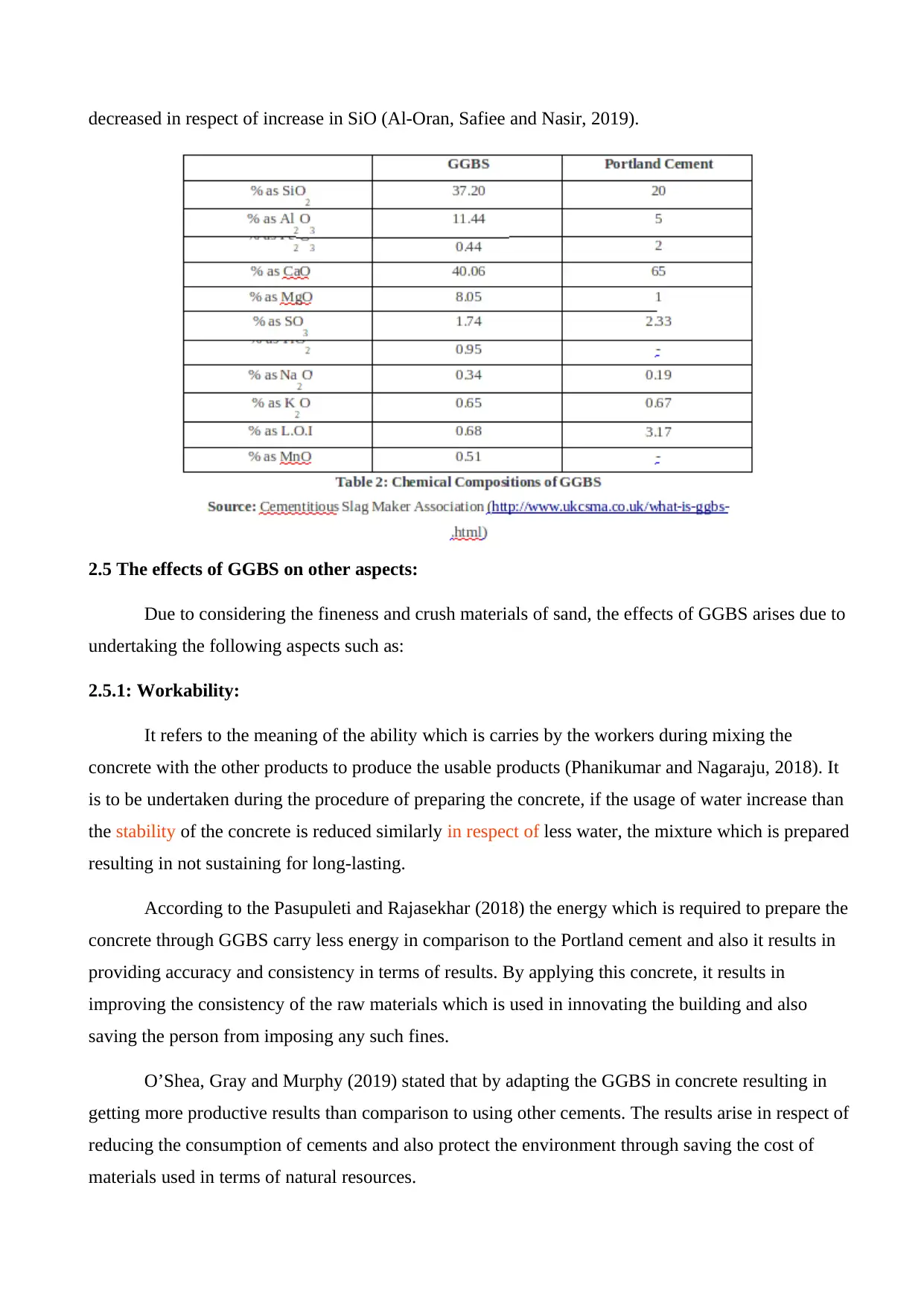
decreased in respect of increase in SiO (Al-Oran, Safiee and Nasir, 2019).
2.5 The effects of GGBS on other aspects:
Due to considering the fineness and crush materials of sand, the effects of GGBS arises due to
undertaking the following aspects such as:
2.5.1: Workability:
It refers to the meaning of the ability which is carries by the workers during mixing the
concrete with the other products to produce the usable products (Phanikumar and Nagaraju, 2018). It
is to be undertaken during the procedure of preparing the concrete, if the usage of water increase than
the stability of the concrete is reduced similarly in respect of less water, the mixture which is prepared
resulting in not sustaining for long-lasting.
According to the Pasupuleti and Rajasekhar (2018) the energy which is required to prepare the
concrete through GGBS carry less energy in comparison to the Portland cement and also it results in
providing accuracy and consistency in terms of results. By applying this concrete, it results in
improving the consistency of the raw materials which is used in innovating the building and also
saving the person from imposing any such fines.
O’Shea, Gray and Murphy (2019) stated that by adapting the GGBS in concrete resulting in
getting more productive results than comparison to using other cements. The results arise in respect of
reducing the consumption of cements and also protect the environment through saving the cost of
materials used in terms of natural resources.
2.5 The effects of GGBS on other aspects:
Due to considering the fineness and crush materials of sand, the effects of GGBS arises due to
undertaking the following aspects such as:
2.5.1: Workability:
It refers to the meaning of the ability which is carries by the workers during mixing the
concrete with the other products to produce the usable products (Phanikumar and Nagaraju, 2018). It
is to be undertaken during the procedure of preparing the concrete, if the usage of water increase than
the stability of the concrete is reduced similarly in respect of less water, the mixture which is prepared
resulting in not sustaining for long-lasting.
According to the Pasupuleti and Rajasekhar (2018) the energy which is required to prepare the
concrete through GGBS carry less energy in comparison to the Portland cement and also it results in
providing accuracy and consistency in terms of results. By applying this concrete, it results in
improving the consistency of the raw materials which is used in innovating the building and also
saving the person from imposing any such fines.
O’Shea, Gray and Murphy (2019) stated that by adapting the GGBS in concrete resulting in
getting more productive results than comparison to using other cements. The results arise in respect of
reducing the consumption of cements and also protect the environment through saving the cost of
materials used in terms of natural resources.
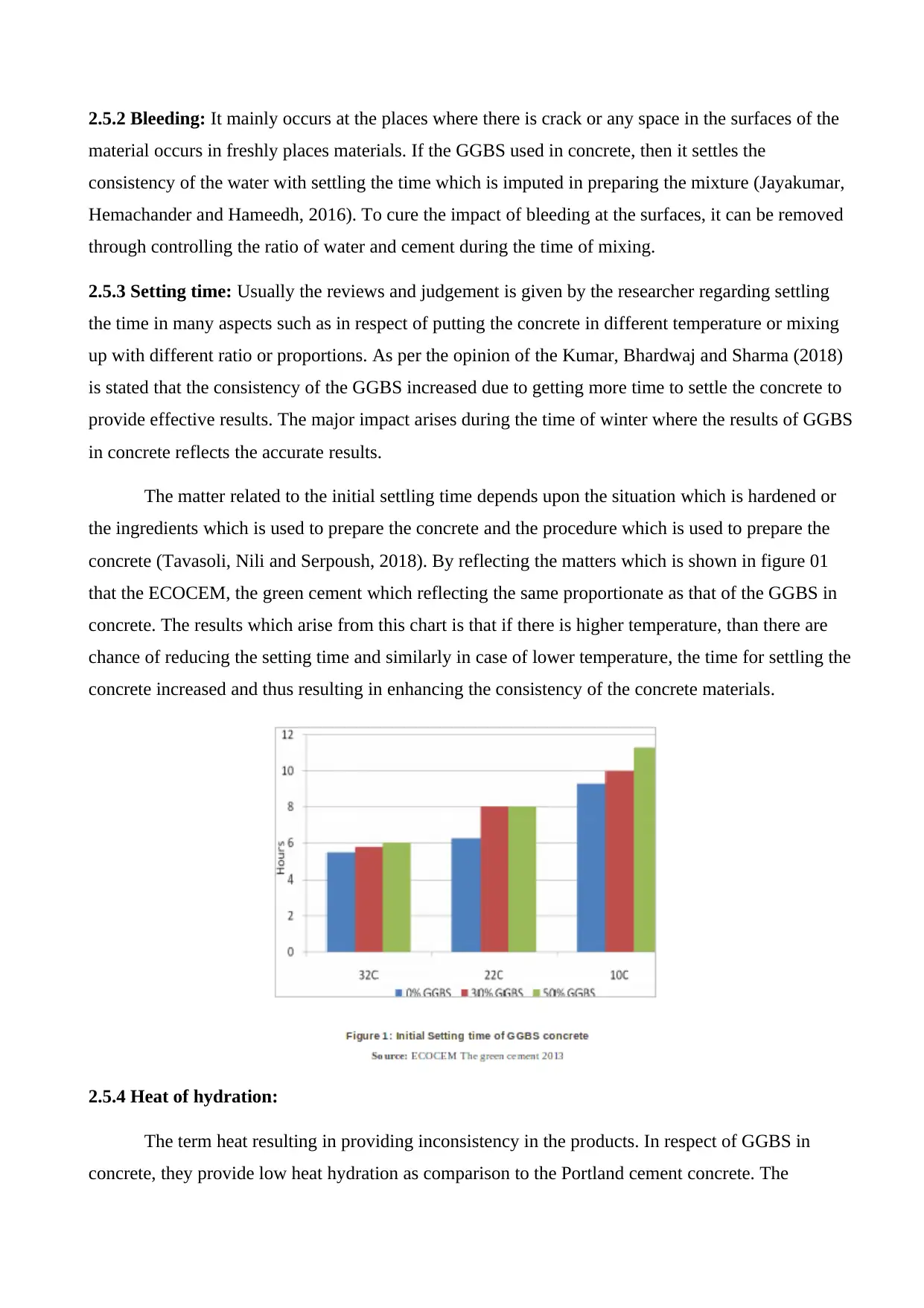
2.5.2 Bleeding: It mainly occurs at the places where there is crack or any space in the surfaces of the
material occurs in freshly places materials. If the GGBS used in concrete, then it settles the
consistency of the water with settling the time which is imputed in preparing the mixture (Jayakumar,
Hemachander and Hameedh, 2016). To cure the impact of bleeding at the surfaces, it can be removed
through controlling the ratio of water and cement during the time of mixing.
2.5.3 Setting time: Usually the reviews and judgement is given by the researcher regarding settling
the time in many aspects such as in respect of putting the concrete in different temperature or mixing
up with different ratio or proportions. As per the opinion of the Kumar, Bhardwaj and Sharma (2018)
is stated that the consistency of the GGBS increased due to getting more time to settle the concrete to
provide effective results. The major impact arises during the time of winter where the results of GGBS
in concrete reflects the accurate results.
The matter related to the initial settling time depends upon the situation which is hardened or
the ingredients which is used to prepare the concrete and the procedure which is used to prepare the
concrete (Tavasoli, Nili and Serpoush, 2018). By reflecting the matters which is shown in figure 01
that the ECOCEM, the green cement which reflecting the same proportionate as that of the GGBS in
concrete. The results which arise from this chart is that if there is higher temperature, than there are
chance of reducing the setting time and similarly in case of lower temperature, the time for settling the
concrete increased and thus resulting in enhancing the consistency of the concrete materials.
2.5.4 Heat of hydration:
The term heat resulting in providing inconsistency in the products. In respect of GGBS in
concrete, they provide low heat hydration as comparison to the Portland cement concrete. The
material occurs in freshly places materials. If the GGBS used in concrete, then it settles the
consistency of the water with settling the time which is imputed in preparing the mixture (Jayakumar,
Hemachander and Hameedh, 2016). To cure the impact of bleeding at the surfaces, it can be removed
through controlling the ratio of water and cement during the time of mixing.
2.5.3 Setting time: Usually the reviews and judgement is given by the researcher regarding settling
the time in many aspects such as in respect of putting the concrete in different temperature or mixing
up with different ratio or proportions. As per the opinion of the Kumar, Bhardwaj and Sharma (2018)
is stated that the consistency of the GGBS increased due to getting more time to settle the concrete to
provide effective results. The major impact arises during the time of winter where the results of GGBS
in concrete reflects the accurate results.
The matter related to the initial settling time depends upon the situation which is hardened or
the ingredients which is used to prepare the concrete and the procedure which is used to prepare the
concrete (Tavasoli, Nili and Serpoush, 2018). By reflecting the matters which is shown in figure 01
that the ECOCEM, the green cement which reflecting the same proportionate as that of the GGBS in
concrete. The results which arise from this chart is that if there is higher temperature, than there are
chance of reducing the setting time and similarly in case of lower temperature, the time for settling the
concrete increased and thus resulting in enhancing the consistency of the concrete materials.
2.5.4 Heat of hydration:
The term heat resulting in providing inconsistency in the products. In respect of GGBS in
concrete, they provide low heat hydration as comparison to the Portland cement concrete. The
Secure Best Marks with AI Grader
Need help grading? Try our AI Grader for instant feedback on your assignments.
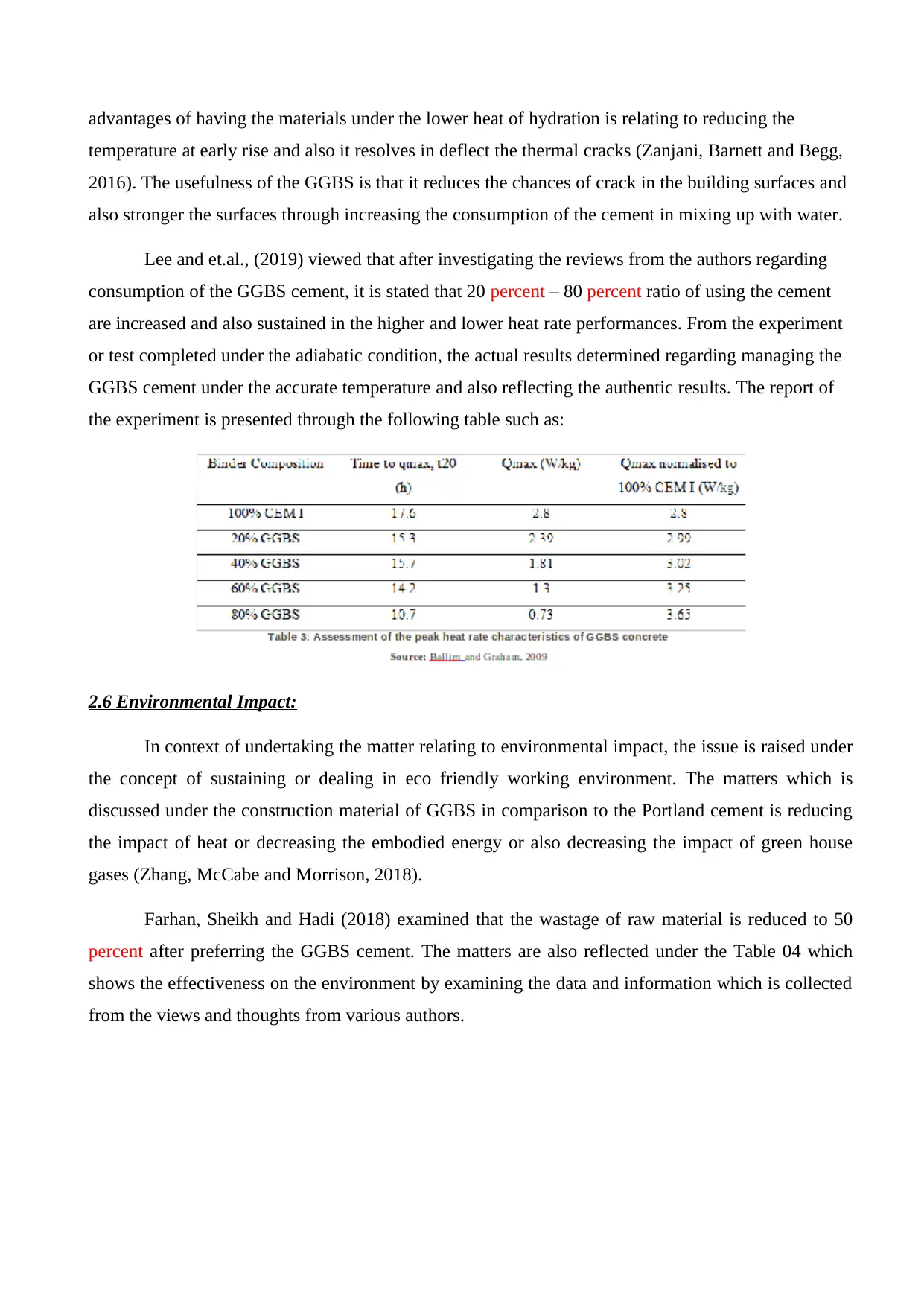
advantages of having the materials under the lower heat of hydration is relating to reducing the
temperature at early rise and also it resolves in deflect the thermal cracks (Zanjani, Barnett and Begg,
2016). The usefulness of the GGBS is that it reduces the chances of crack in the building surfaces and
also stronger the surfaces through increasing the consumption of the cement in mixing up with water.
Lee and et.al., (2019) viewed that after investigating the reviews from the authors regarding
consumption of the GGBS cement, it is stated that 20 percent – 80 percent ratio of using the cement
are increased and also sustained in the higher and lower heat rate performances. From the experiment
or test completed under the adiabatic condition, the actual results determined regarding managing the
GGBS cement under the accurate temperature and also reflecting the authentic results. The report of
the experiment is presented through the following table such as:
2.6 Environmental Impact:
In context of undertaking the matter relating to environmental impact, the issue is raised under
the concept of sustaining or dealing in eco friendly working environment. The matters which is
discussed under the construction material of GGBS in comparison to the Portland cement is reducing
the impact of heat or decreasing the embodied energy or also decreasing the impact of green house
gases (Zhang, McCabe and Morrison, 2018).
Farhan, Sheikh and Hadi (2018) examined that the wastage of raw material is reduced to 50
percent after preferring the GGBS cement. The matters are also reflected under the Table 04 which
shows the effectiveness on the environment by examining the data and information which is collected
from the views and thoughts from various authors.
temperature at early rise and also it resolves in deflect the thermal cracks (Zanjani, Barnett and Begg,
2016). The usefulness of the GGBS is that it reduces the chances of crack in the building surfaces and
also stronger the surfaces through increasing the consumption of the cement in mixing up with water.
Lee and et.al., (2019) viewed that after investigating the reviews from the authors regarding
consumption of the GGBS cement, it is stated that 20 percent – 80 percent ratio of using the cement
are increased and also sustained in the higher and lower heat rate performances. From the experiment
or test completed under the adiabatic condition, the actual results determined regarding managing the
GGBS cement under the accurate temperature and also reflecting the authentic results. The report of
the experiment is presented through the following table such as:
2.6 Environmental Impact:
In context of undertaking the matter relating to environmental impact, the issue is raised under
the concept of sustaining or dealing in eco friendly working environment. The matters which is
discussed under the construction material of GGBS in comparison to the Portland cement is reducing
the impact of heat or decreasing the embodied energy or also decreasing the impact of green house
gases (Zhang, McCabe and Morrison, 2018).
Farhan, Sheikh and Hadi (2018) examined that the wastage of raw material is reduced to 50
percent after preferring the GGBS cement. The matters are also reflected under the Table 04 which
shows the effectiveness on the environment by examining the data and information which is collected
from the views and thoughts from various authors.
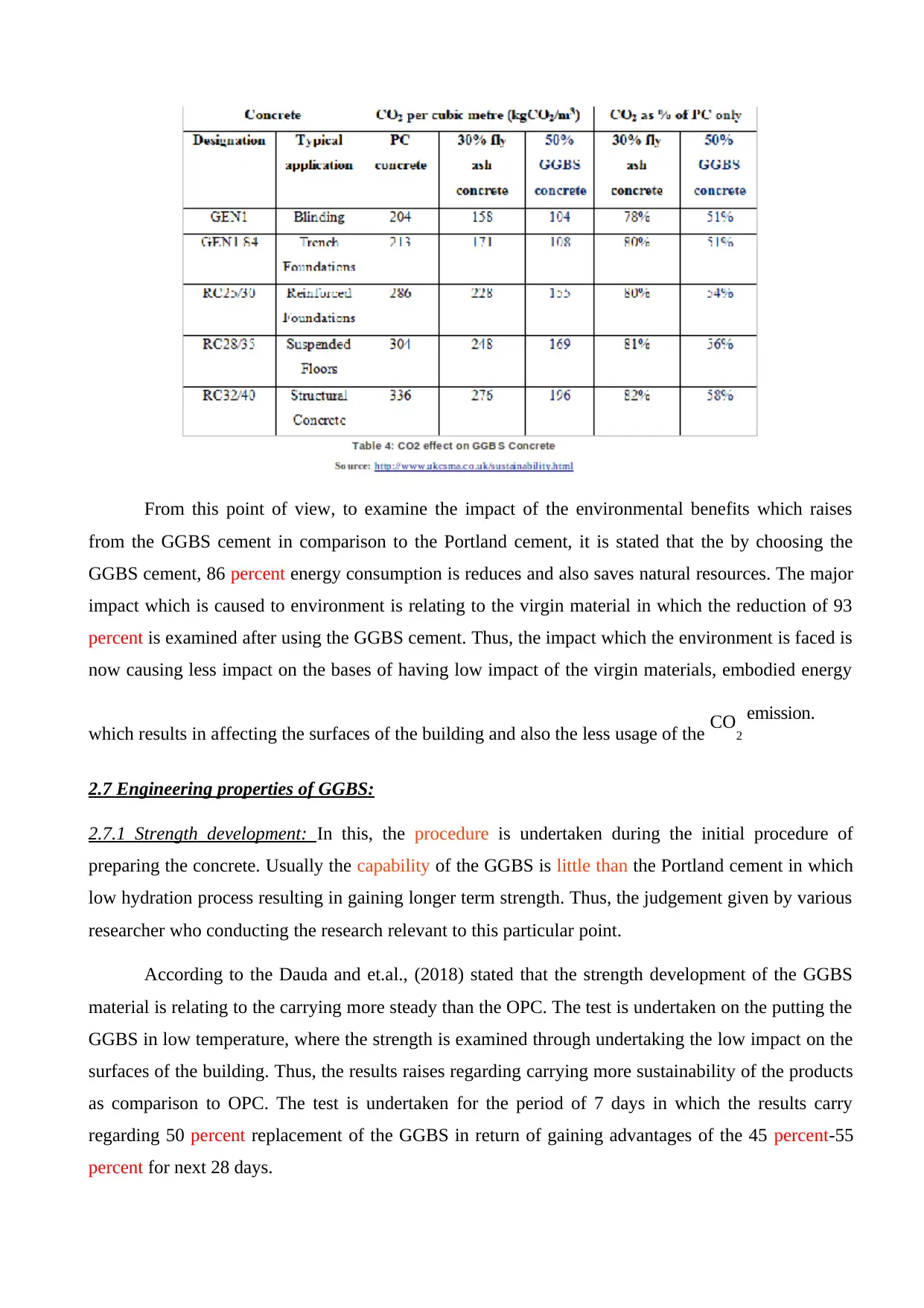
From this point of view, to examine the impact of the environmental benefits which raises
from the GGBS cement in comparison to the Portland cement, it is stated that the by choosing the
GGBS cement, 86 percent energy consumption is reduces and also saves natural resources. The major
impact which is caused to environment is relating to the virgin material in which the reduction of 93
percent is examined after using the GGBS cement. Thus, the impact which the environment is faced is
now causing less impact on the bases of having low impact of the virgin materials, embodied energy
which results in affecting the surfaces of the building and also the less usage of the CO2
emission.
2.7 Engineering properties of GGBS:
2.7.1 Strength development: In this, the procedure is undertaken during the initial procedure of
preparing the concrete. Usually the capability of the GGBS is little than the Portland cement in which
low hydration process resulting in gaining longer term strength. Thus, the judgement given by various
researcher who conducting the research relevant to this particular point.
According to the Dauda and et.al., (2018) stated that the strength development of the GGBS
material is relating to the carrying more steady than the OPC. The test is undertaken on the putting the
GGBS in low temperature, where the strength is examined through undertaking the low impact on the
surfaces of the building. Thus, the results raises regarding carrying more sustainability of the products
as comparison to OPC. The test is undertaken for the period of 7 days in which the results carry
regarding 50 percent replacement of the GGBS in return of gaining advantages of the 45 percent-55
percent for next 28 days.
from the GGBS cement in comparison to the Portland cement, it is stated that the by choosing the
GGBS cement, 86 percent energy consumption is reduces and also saves natural resources. The major
impact which is caused to environment is relating to the virgin material in which the reduction of 93
percent is examined after using the GGBS cement. Thus, the impact which the environment is faced is
now causing less impact on the bases of having low impact of the virgin materials, embodied energy
which results in affecting the surfaces of the building and also the less usage of the CO2
emission.
2.7 Engineering properties of GGBS:
2.7.1 Strength development: In this, the procedure is undertaken during the initial procedure of
preparing the concrete. Usually the capability of the GGBS is little than the Portland cement in which
low hydration process resulting in gaining longer term strength. Thus, the judgement given by various
researcher who conducting the research relevant to this particular point.
According to the Dauda and et.al., (2018) stated that the strength development of the GGBS
material is relating to the carrying more steady than the OPC. The test is undertaken on the putting the
GGBS in low temperature, where the strength is examined through undertaking the low impact on the
surfaces of the building. Thus, the results raises regarding carrying more sustainability of the products
as comparison to OPC. The test is undertaken for the period of 7 days in which the results carry
regarding 50 percent replacement of the GGBS in return of gaining advantages of the 45 percent-55
percent for next 28 days.
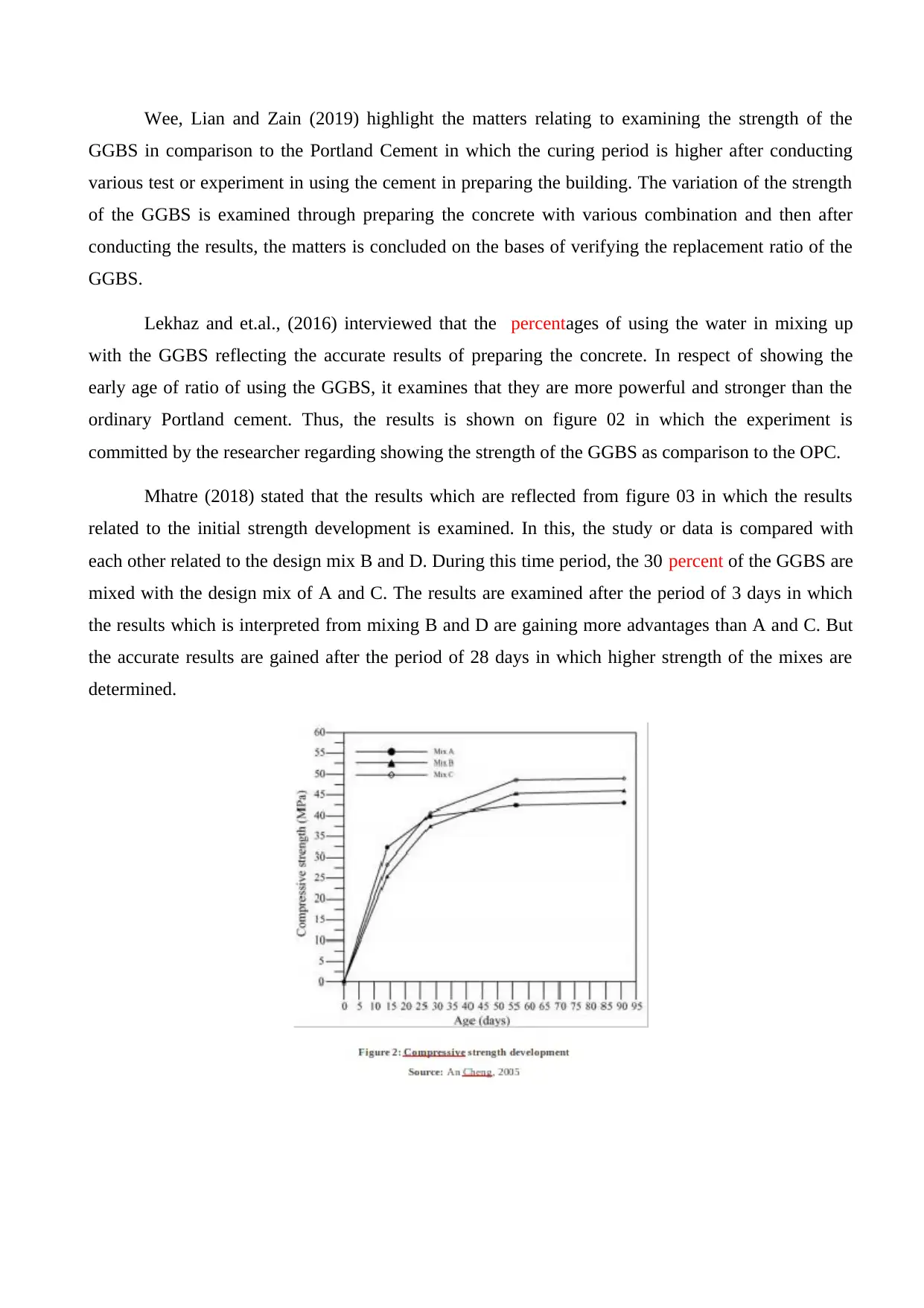
Wee, Lian and Zain (2019) highlight the matters relating to examining the strength of the
GGBS in comparison to the Portland Cement in which the curing period is higher after conducting
various test or experiment in using the cement in preparing the building. The variation of the strength
of the GGBS is examined through preparing the concrete with various combination and then after
conducting the results, the matters is concluded on the bases of verifying the replacement ratio of the
GGBS.
Lekhaz and et.al., (2016) interviewed that the percentages of using the water in mixing up
with the GGBS reflecting the accurate results of preparing the concrete. In respect of showing the
early age of ratio of using the GGBS, it examines that they are more powerful and stronger than the
ordinary Portland cement. Thus, the results is shown on figure 02 in which the experiment is
committed by the researcher regarding showing the strength of the GGBS as comparison to the OPC.
Mhatre (2018) stated that the results which are reflected from figure 03 in which the results
related to the initial strength development is examined. In this, the study or data is compared with
each other related to the design mix B and D. During this time period, the 30 percent of the GGBS are
mixed with the design mix of A and C. The results are examined after the period of 3 days in which
the results which is interpreted from mixing B and D are gaining more advantages than A and C. But
the accurate results are gained after the period of 28 days in which higher strength of the mixes are
determined.
GGBS in comparison to the Portland Cement in which the curing period is higher after conducting
various test or experiment in using the cement in preparing the building. The variation of the strength
of the GGBS is examined through preparing the concrete with various combination and then after
conducting the results, the matters is concluded on the bases of verifying the replacement ratio of the
GGBS.
Lekhaz and et.al., (2016) interviewed that the percentages of using the water in mixing up
with the GGBS reflecting the accurate results of preparing the concrete. In respect of showing the
early age of ratio of using the GGBS, it examines that they are more powerful and stronger than the
ordinary Portland cement. Thus, the results is shown on figure 02 in which the experiment is
committed by the researcher regarding showing the strength of the GGBS as comparison to the OPC.
Mhatre (2018) stated that the results which are reflected from figure 03 in which the results
related to the initial strength development is examined. In this, the study or data is compared with
each other related to the design mix B and D. During this time period, the 30 percent of the GGBS are
mixed with the design mix of A and C. The results are examined after the period of 3 days in which
the results which is interpreted from mixing B and D are gaining more advantages than A and C. But
the accurate results are gained after the period of 28 days in which higher strength of the mixes are
determined.
Paraphrase This Document
Need a fresh take? Get an instant paraphrase of this document with our AI Paraphraser

From this above graph, the study is undertaken the bases of examining the high level of the
concrete strength development in which the discussion is based upon the GGBS as a replacement
criteria. It is stated that the strength of concrete material is identified after verifying the impact of 28
days time period in which the 200C is extremely affected by the replacement of the GGBS.
According to Pavía and Aly (2016) the report conclude the matters relating to putting the
concrete under the normal temperature and thus reflecting the results in form of slower down of the
GGBS in comparison to the OPC. In respect of undertaking the procedure of replacing the cement,
it is stated that after 28 days, the results examined through availing the equivalent proportionate of
water with the mixture top prepare the concrete.
Abutaha, Abdul Razak and Ibrahim (2017) suggested that the results which arises of GGBS
in winter is very low as the impact occurred in two perspective such as:
In case of GBBS, they mainly carry the slower down procedure as comparison to Portland
cement during the hydration process. In context of measuring the ratio of water which is imposed during the procedure of the
mixing the cement to prepare concrete results in managing the quality in right manner. In
respect of putting extra water resulting in less strong of the concrete and also bring crack at
the surface area. Thus, same amount of water is mixed with the cement to prepare the
accurate concrete and results in sustaining the amount of products which is utilized in
constructing building.
concrete strength development in which the discussion is based upon the GGBS as a replacement
criteria. It is stated that the strength of concrete material is identified after verifying the impact of 28
days time period in which the 200C is extremely affected by the replacement of the GGBS.
According to Pavía and Aly (2016) the report conclude the matters relating to putting the
concrete under the normal temperature and thus reflecting the results in form of slower down of the
GGBS in comparison to the OPC. In respect of undertaking the procedure of replacing the cement,
it is stated that after 28 days, the results examined through availing the equivalent proportionate of
water with the mixture top prepare the concrete.
Abutaha, Abdul Razak and Ibrahim (2017) suggested that the results which arises of GGBS
in winter is very low as the impact occurred in two perspective such as:
In case of GBBS, they mainly carry the slower down procedure as comparison to Portland
cement during the hydration process. In context of measuring the ratio of water which is imposed during the procedure of the
mixing the cement to prepare concrete results in managing the quality in right manner. In
respect of putting extra water resulting in less strong of the concrete and also bring crack at
the surface area. Thus, same amount of water is mixed with the cement to prepare the
accurate concrete and results in sustaining the amount of products which is utilized in
constructing building.
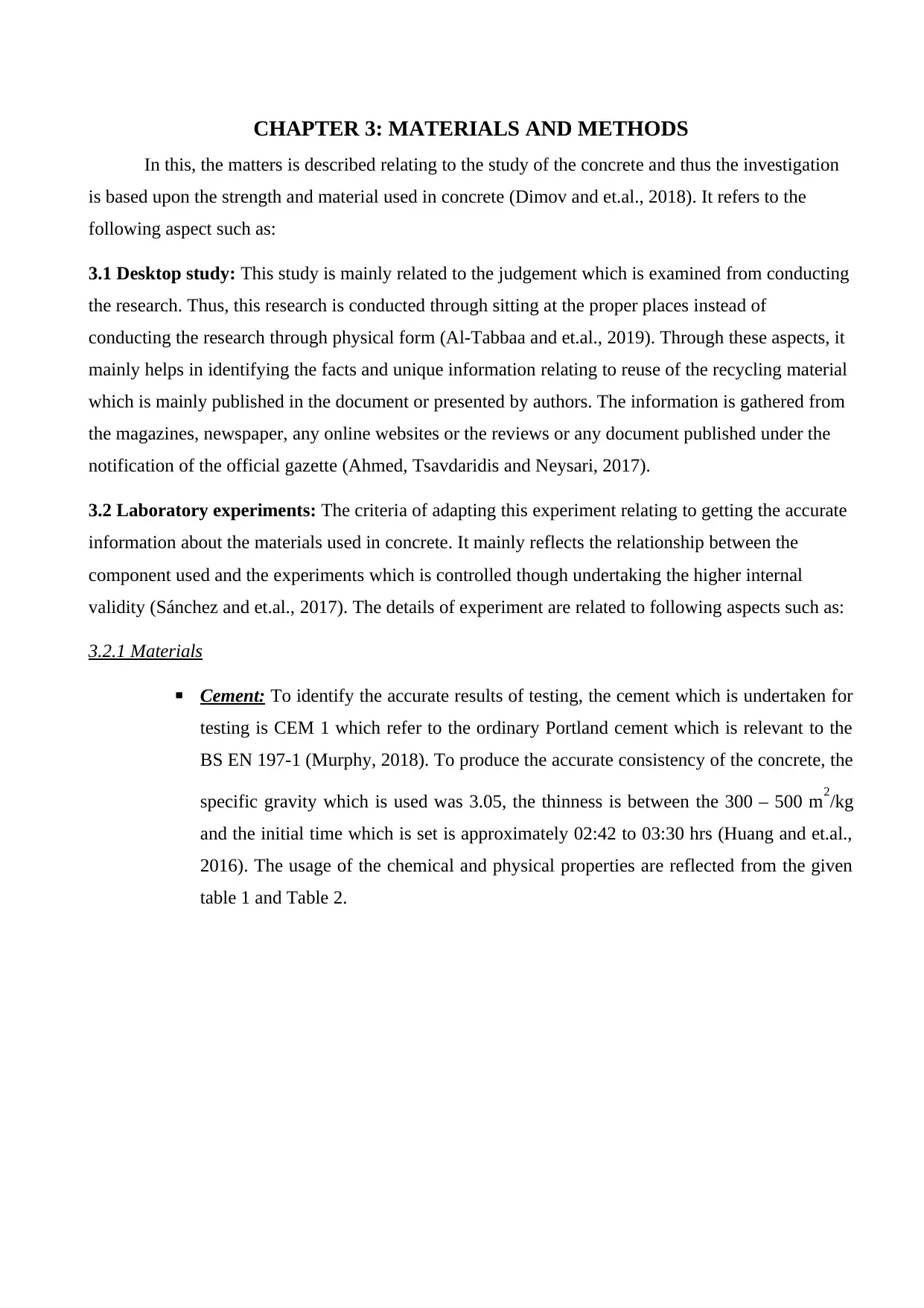
CHAPTER 3: MATERIALS AND METHODS
In this, the matters is described relating to the study of the concrete and thus the investigation
is based upon the strength and material used in concrete (Dimov and et.al., 2018). It refers to the
following aspect such as:
3.1 Desktop study: This study is mainly related to the judgement which is examined from conducting
the research. Thus, this research is conducted through sitting at the proper places instead of
conducting the research through physical form (Al-Tabbaa and et.al., 2019). Through these aspects, it
mainly helps in identifying the facts and unique information relating to reuse of the recycling material
which is mainly published in the document or presented by authors. The information is gathered from
the magazines, newspaper, any online websites or the reviews or any document published under the
notification of the official gazette (Ahmed, Tsavdaridis and Neysari, 2017).
3.2 Laboratory experiments: The criteria of adapting this experiment relating to getting the accurate
information about the materials used in concrete. It mainly reflects the relationship between the
component used and the experiments which is controlled though undertaking the higher internal
validity (Sánchez and et.al., 2017). The details of experiment are related to following aspects such as:
3.2.1 Materials
▪ Cement: To identify the accurate results of testing, the cement which is undertaken for
testing is CEM 1 which refer to the ordinary Portland cement which is relevant to the
BS EN 197-1 (Murphy, 2018). To produce the accurate consistency of the concrete, the
specific gravity which is used was 3.05, the thinness is between the 300 – 500 m2/kg
and the initial time which is set is approximately 02:42 to 03:30 hrs (Huang and et.al.,
2016). The usage of the chemical and physical properties are reflected from the given
table 1 and Table 2.
In this, the matters is described relating to the study of the concrete and thus the investigation
is based upon the strength and material used in concrete (Dimov and et.al., 2018). It refers to the
following aspect such as:
3.1 Desktop study: This study is mainly related to the judgement which is examined from conducting
the research. Thus, this research is conducted through sitting at the proper places instead of
conducting the research through physical form (Al-Tabbaa and et.al., 2019). Through these aspects, it
mainly helps in identifying the facts and unique information relating to reuse of the recycling material
which is mainly published in the document or presented by authors. The information is gathered from
the magazines, newspaper, any online websites or the reviews or any document published under the
notification of the official gazette (Ahmed, Tsavdaridis and Neysari, 2017).
3.2 Laboratory experiments: The criteria of adapting this experiment relating to getting the accurate
information about the materials used in concrete. It mainly reflects the relationship between the
component used and the experiments which is controlled though undertaking the higher internal
validity (Sánchez and et.al., 2017). The details of experiment are related to following aspects such as:
3.2.1 Materials
▪ Cement: To identify the accurate results of testing, the cement which is undertaken for
testing is CEM 1 which refer to the ordinary Portland cement which is relevant to the
BS EN 197-1 (Murphy, 2018). To produce the accurate consistency of the concrete, the
specific gravity which is used was 3.05, the thinness is between the 300 – 500 m2/kg
and the initial time which is set is approximately 02:42 to 03:30 hrs (Huang and et.al.,
2016). The usage of the chemical and physical properties are reflected from the given
table 1 and Table 2.
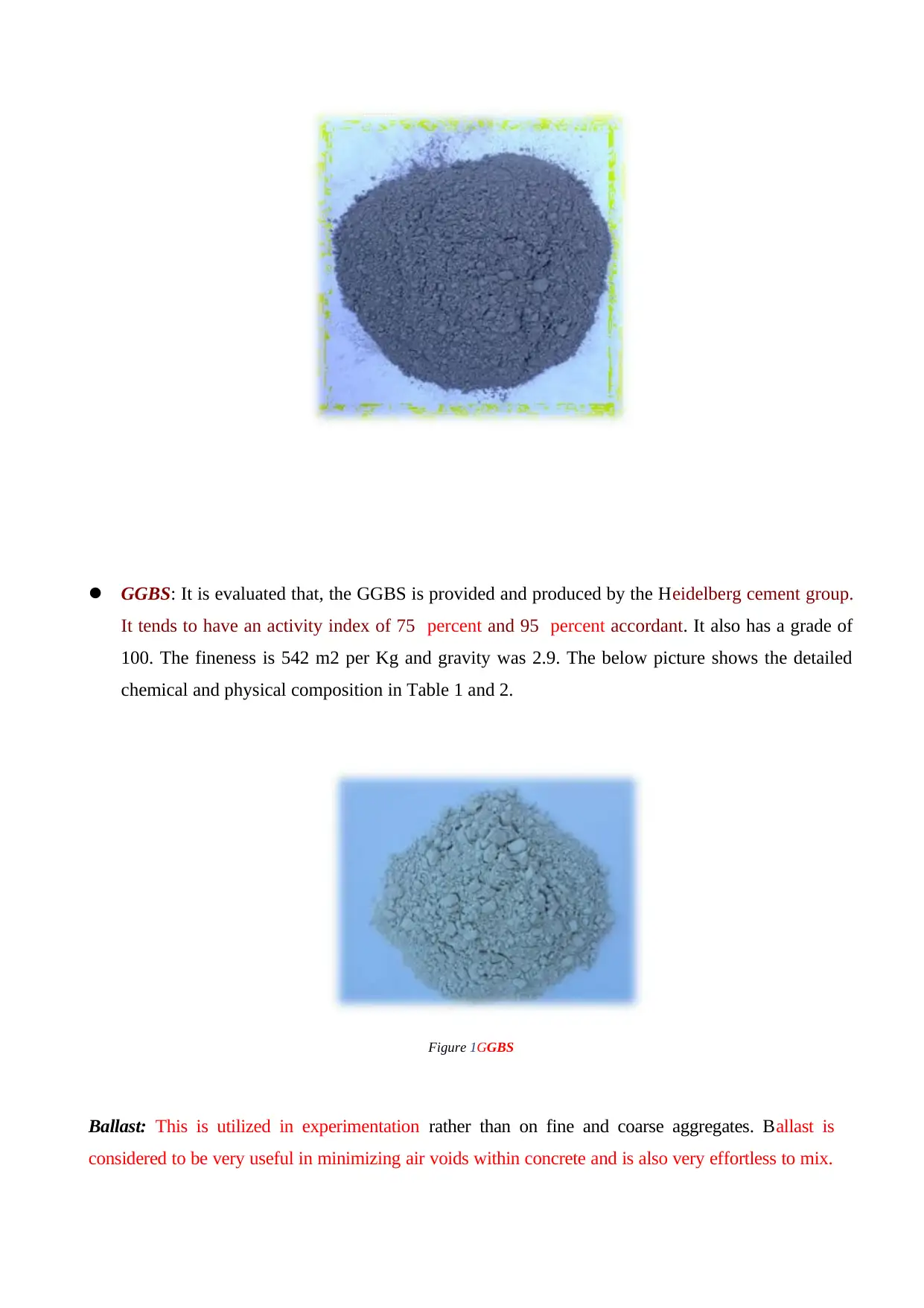
GGBS: It is evaluated that, the GGBS is provided and produced by the Heidelberg cement group.
It tends to have an activity index of 75 percent and 95 percent accordant. It also has a grade of
100. The fineness is 542 m2 per Kg and gravity was 2.9. The below picture shows the detailed
chemical and physical composition in Table 1 and 2.
Figure 1GGBS
Ballast: This is utilized in experimentation rather than on fine and coarse aggregates. Ballast is
considered to be very useful in minimizing air voids within concrete and is also very effortless to mix.
It tends to have an activity index of 75 percent and 95 percent accordant. It also has a grade of
100. The fineness is 542 m2 per Kg and gravity was 2.9. The below picture shows the detailed
chemical and physical composition in Table 1 and 2.
Figure 1GGBS
Ballast: This is utilized in experimentation rather than on fine and coarse aggregates. Ballast is
considered to be very useful in minimizing air voids within concrete and is also very effortless to mix.
Secure Best Marks with AI Grader
Need help grading? Try our AI Grader for instant feedback on your assignments.

The Ballast has shifted from 20 millimeters to 10 millimeters. Hence the maximal size associated with
the Ballast is 10mm as only 100 mm3 magnitude of cube are accessible.
the Ballast is 10mm as only 100 mm3 magnitude of cube are accessible.
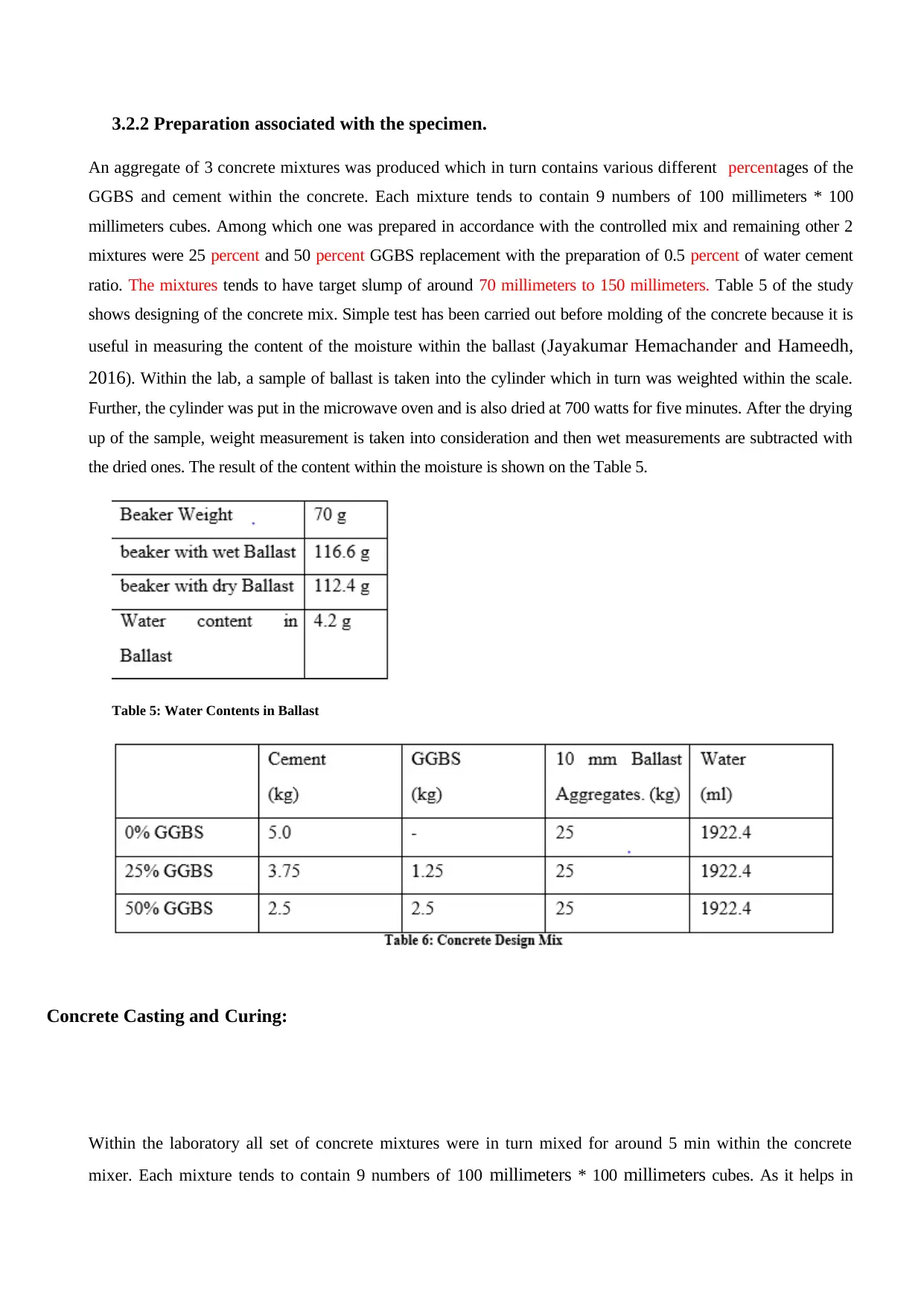
3.2.2 Preparation associated with the specimen.
An aggregate of 3 concrete mixtures was produced which in turn contains various different percentages of the
GGBS and cement within the concrete. Each mixture tends to contain 9 numbers of 100 millimeters * 100
millimeters cubes. Among which one was prepared in accordance with the controlled mix and remaining other 2
mixtures were 25 percent and 50 percent GGBS replacement with the preparation of 0.5 percent of water cement
ratio. The mixtures tends to have target slump of around 70 millimeters to 150 millimeters. Table 5 of the study
shows designing of the concrete mix. Simple test has been carried out before molding of the concrete because it is
useful in measuring the content of the moisture within the ballast (Jayakumar Hemachander and Hameedh,
2016). Within the lab, a sample of ballast is taken into the cylinder which in turn was weighted within the scale.
Further, the cylinder was put in the microwave oven and is also dried at 700 watts for five minutes. After the drying
up of the sample, weight measurement is taken into consideration and then wet measurements are subtracted with
the dried ones. The result of the content within the moisture is shown on the Table 5.
Table 5: Water Contents in Ballast
Concrete Casting and Curing:
Within the laboratory all set of concrete mixtures were in turn mixed for around 5 min within the concrete
mixer. Each mixture tends to contain 9 numbers of 100 millimeters * 100 millimeters cubes. As it helps in
An aggregate of 3 concrete mixtures was produced which in turn contains various different percentages of the
GGBS and cement within the concrete. Each mixture tends to contain 9 numbers of 100 millimeters * 100
millimeters cubes. Among which one was prepared in accordance with the controlled mix and remaining other 2
mixtures were 25 percent and 50 percent GGBS replacement with the preparation of 0.5 percent of water cement
ratio. The mixtures tends to have target slump of around 70 millimeters to 150 millimeters. Table 5 of the study
shows designing of the concrete mix. Simple test has been carried out before molding of the concrete because it is
useful in measuring the content of the moisture within the ballast (Jayakumar Hemachander and Hameedh,
2016). Within the lab, a sample of ballast is taken into the cylinder which in turn was weighted within the scale.
Further, the cylinder was put in the microwave oven and is also dried at 700 watts for five minutes. After the drying
up of the sample, weight measurement is taken into consideration and then wet measurements are subtracted with
the dried ones. The result of the content within the moisture is shown on the Table 5.
Table 5: Water Contents in Ballast
Concrete Casting and Curing:
Within the laboratory all set of concrete mixtures were in turn mixed for around 5 min within the concrete
mixer. Each mixture tends to contain 9 numbers of 100 millimeters * 100 millimeters cubes. As it helps in
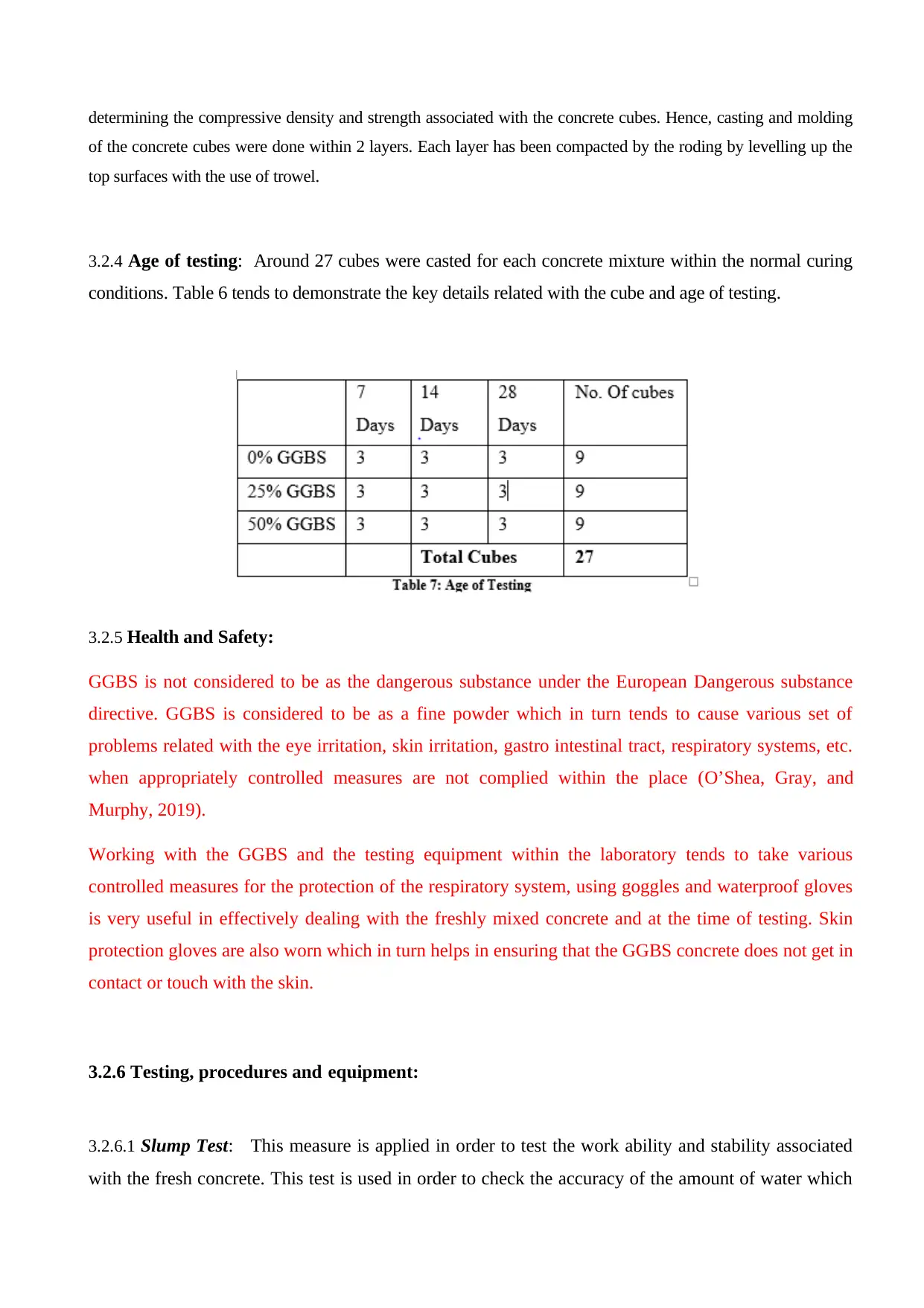
determining the compressive density and strength associated with the concrete cubes. Hence, casting and molding
of the concrete cubes were done within 2 layers. Each layer has been compacted by the roding by levelling up the
top surfaces with the use of trowel.
3.2.4 Age of testing: Around 27 cubes were casted for each concrete mixture within the normal curing
conditions. Table 6 tends to demonstrate the key details related with the cube and age of testing.
3.2.5 Health and Safety:
GGBS is not considered to be as the dangerous substance under the European Dangerous substance
directive. GGBS is considered to be as a fine powder which in turn tends to cause various set of
problems related with the eye irritation, skin irritation, gastro intestinal tract, respiratory systems, etc.
when appropriately controlled measures are not complied within the place (O’Shea, Gray, and
Murphy, 2019).
Working with the GGBS and the testing equipment within the laboratory tends to take various
controlled measures for the protection of the respiratory system, using goggles and waterproof gloves
is very useful in effectively dealing with the freshly mixed concrete and at the time of testing. Skin
protection gloves are also worn which in turn helps in ensuring that the GGBS concrete does not get in
contact or touch with the skin.
3.2.6 Testing, procedures and equipment:
3.2.6.1 Slump Test: This measure is applied in order to test the work ability and stability associated
with the fresh concrete. This test is used in order to check the accuracy of the amount of water which
of the concrete cubes were done within 2 layers. Each layer has been compacted by the roding by levelling up the
top surfaces with the use of trowel.
3.2.4 Age of testing: Around 27 cubes were casted for each concrete mixture within the normal curing
conditions. Table 6 tends to demonstrate the key details related with the cube and age of testing.
3.2.5 Health and Safety:
GGBS is not considered to be as the dangerous substance under the European Dangerous substance
directive. GGBS is considered to be as a fine powder which in turn tends to cause various set of
problems related with the eye irritation, skin irritation, gastro intestinal tract, respiratory systems, etc.
when appropriately controlled measures are not complied within the place (O’Shea, Gray, and
Murphy, 2019).
Working with the GGBS and the testing equipment within the laboratory tends to take various
controlled measures for the protection of the respiratory system, using goggles and waterproof gloves
is very useful in effectively dealing with the freshly mixed concrete and at the time of testing. Skin
protection gloves are also worn which in turn helps in ensuring that the GGBS concrete does not get in
contact or touch with the skin.
3.2.6 Testing, procedures and equipment:
3.2.6.1 Slump Test: This measure is applied in order to test the work ability and stability associated
with the fresh concrete. This test is used in order to check the accuracy of the amount of water which
Paraphrase This Document
Need a fresh take? Get an instant paraphrase of this document with our AI Paraphraser
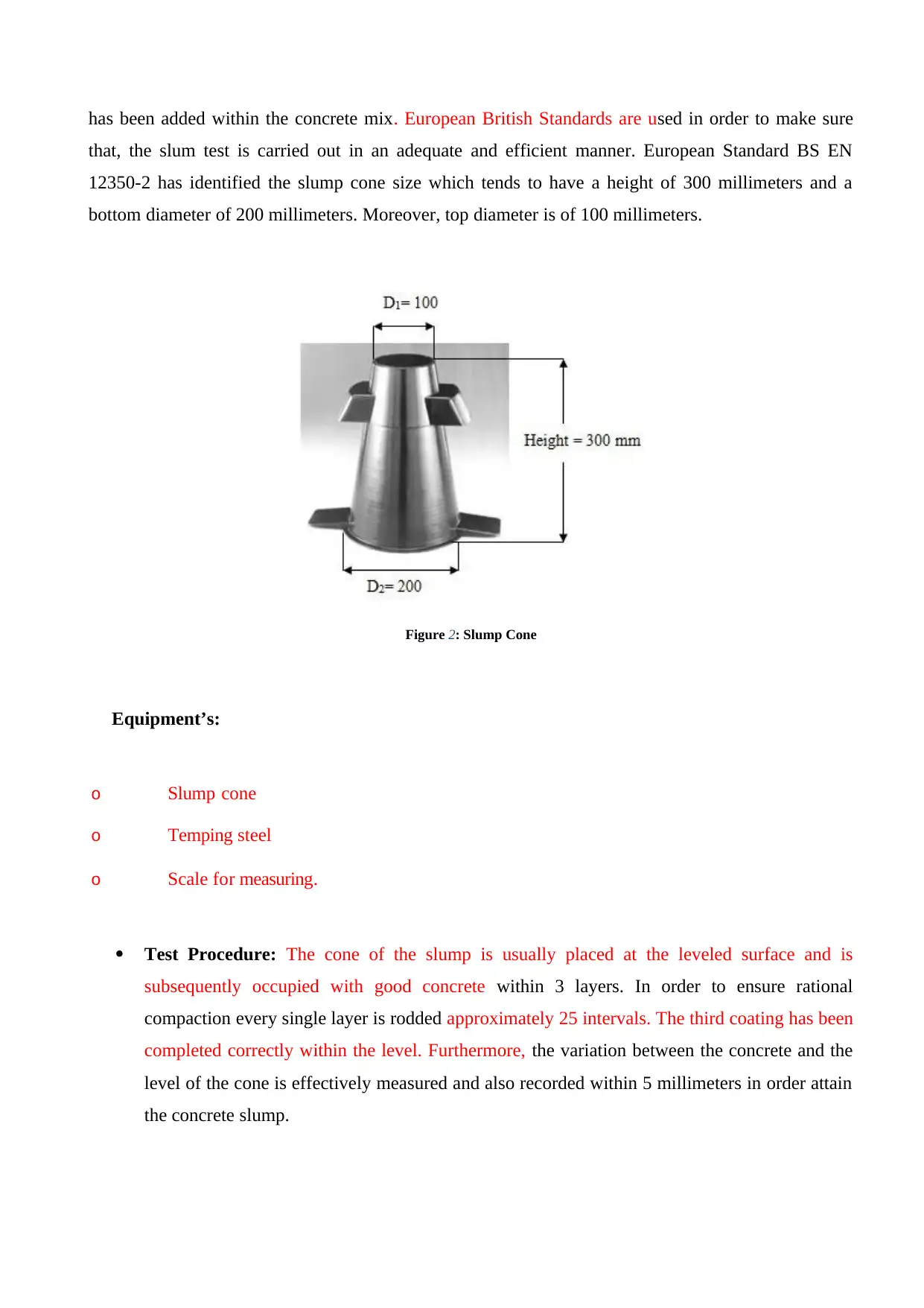
has been added within the concrete mix. European British Standards are used in order to make sure
that, the slum test is carried out in an adequate and efficient manner. European Standard BS EN
12350-2 has identified the slump cone size which tends to have a height of 300 millimeters and a
bottom diameter of 200 millimeters. Moreover, top diameter is of 100 millimeters.
Figure 2: Slump Cone
Equipment’s:
o Slump cone
o Temping steel
o Scale for measuring.
Test Procedure: The cone of the slump is usually placed at the leveled surface and is
subsequently occupied with good concrete within 3 layers. In order to ensure rational
compaction every single layer is rodded approximately 25 intervals. The third coating has been
completed correctly within the level. Furthermore, the variation between the concrete and the
level of the cone is effectively measured and also recorded within 5 millimeters in order attain
the concrete slump.
that, the slum test is carried out in an adequate and efficient manner. European Standard BS EN
12350-2 has identified the slump cone size which tends to have a height of 300 millimeters and a
bottom diameter of 200 millimeters. Moreover, top diameter is of 100 millimeters.
Figure 2: Slump Cone
Equipment’s:
o Slump cone
o Temping steel
o Scale for measuring.
Test Procedure: The cone of the slump is usually placed at the leveled surface and is
subsequently occupied with good concrete within 3 layers. In order to ensure rational
compaction every single layer is rodded approximately 25 intervals. The third coating has been
completed correctly within the level. Furthermore, the variation between the concrete and the
level of the cone is effectively measured and also recorded within 5 millimeters in order attain
the concrete slump.
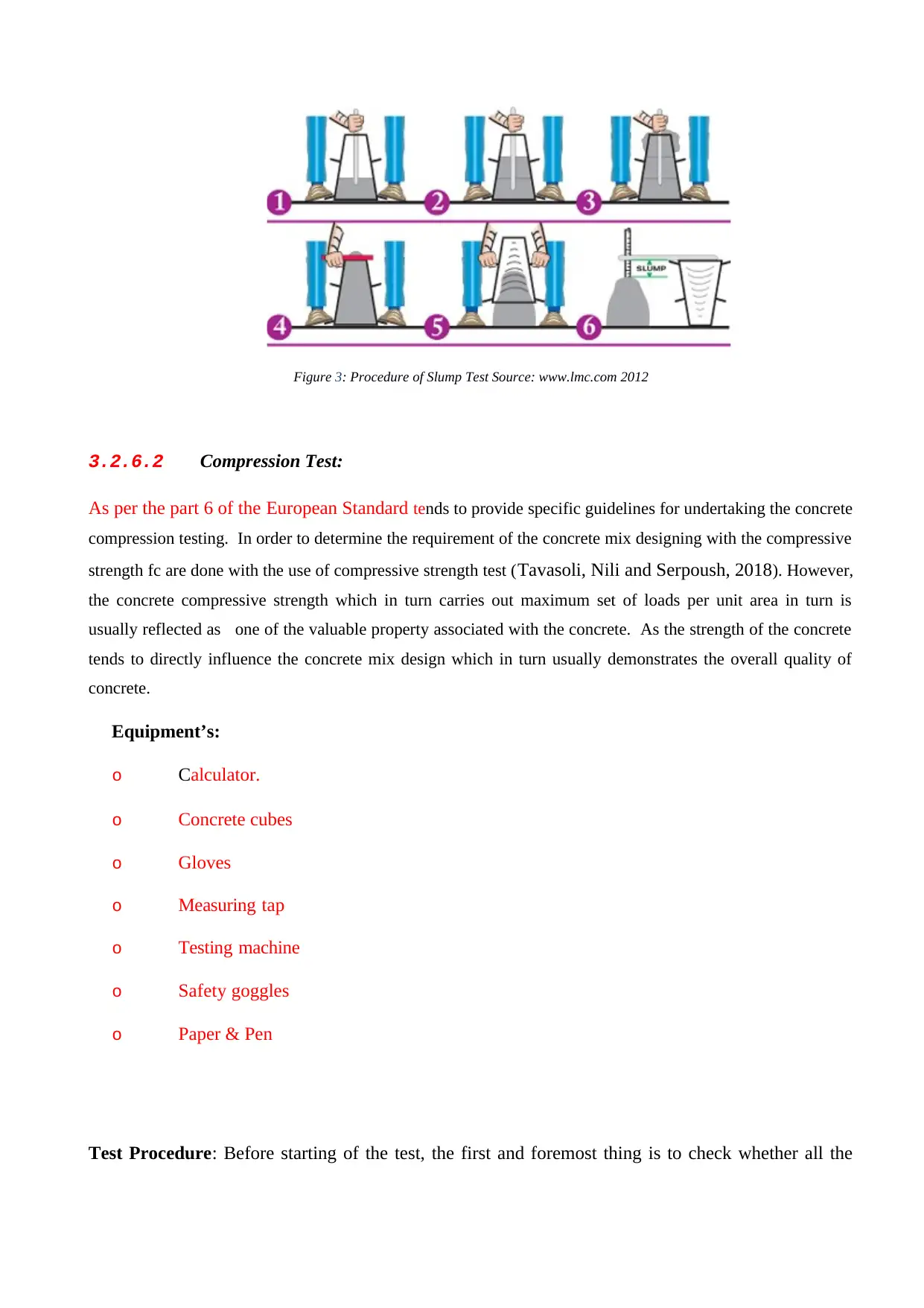
Figure 3: Procedure of Slump Test Source: www.lmc.com 2012
3.2.6.2 Compression Test:
As per the part 6 of the European Standard tends to provide specific guidelines for undertaking the concrete
compression testing. In order to determine the requirement of the concrete mix designing with the compressive
strength fc are done with the use of compressive strength test (Tavasoli, Nili and Serpoush, 2018). However,
the concrete compressive strength which in turn carries out maximum set of loads per unit area in turn is
usually reflected as one of the valuable property associated with the concrete. As the strength of the concrete
tends to directly influence the concrete mix design which in turn usually demonstrates the overall quality of
concrete.
Equipment’s:
o Calculator.
o Concrete cubes
o Gloves
o Measuring tap
o Testing machine
o Safety goggles
o Paper & Pen
Test Procedure: Before starting of the test, the first and foremost thing is to check whether all the
3.2.6.2 Compression Test:
As per the part 6 of the European Standard tends to provide specific guidelines for undertaking the concrete
compression testing. In order to determine the requirement of the concrete mix designing with the compressive
strength fc are done with the use of compressive strength test (Tavasoli, Nili and Serpoush, 2018). However,
the concrete compressive strength which in turn carries out maximum set of loads per unit area in turn is
usually reflected as one of the valuable property associated with the concrete. As the strength of the concrete
tends to directly influence the concrete mix design which in turn usually demonstrates the overall quality of
concrete.
Equipment’s:
o Calculator.
o Concrete cubes
o Gloves
o Measuring tap
o Testing machine
o Safety goggles
o Paper & Pen
Test Procedure: Before starting of the test, the first and foremost thing is to check whether all the
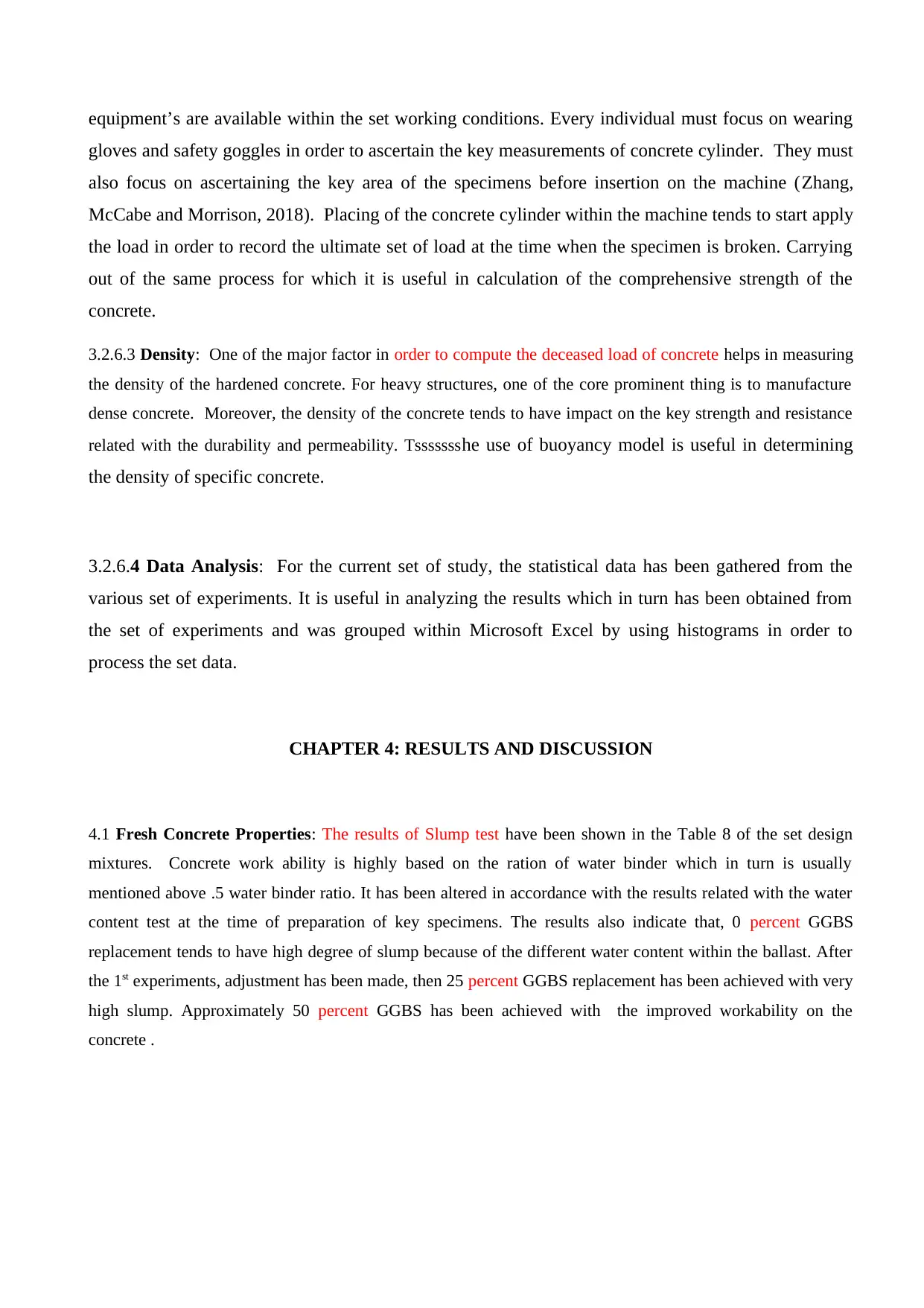
equipment’s are available within the set working conditions. Every individual must focus on wearing
gloves and safety goggles in order to ascertain the key measurements of concrete cylinder. They must
also focus on ascertaining the key area of the specimens before insertion on the machine (Zhang,
McCabe and Morrison, 2018). Placing of the concrete cylinder within the machine tends to start apply
the load in order to record the ultimate set of load at the time when the specimen is broken. Carrying
out of the same process for which it is useful in calculation of the comprehensive strength of the
concrete.
3.2.6.3 Density: One of the major factor in order to compute the deceased load of concrete helps in measuring
the density of the hardened concrete. For heavy structures, one of the core prominent thing is to manufacture
dense concrete. Moreover, the density of the concrete tends to have impact on the key strength and resistance
related with the durability and permeability. Tssssssshe use of buoyancy model is useful in determining
the density of specific concrete.
3.2.6.4 Data Analysis: For the current set of study, the statistical data has been gathered from the
various set of experiments. It is useful in analyzing the results which in turn has been obtained from
the set of experiments and was grouped within Microsoft Excel by using histograms in order to
process the set data.
CHAPTER 4: RESULTS AND DISCUSSION
4.1 Fresh Concrete Properties: The results of Slump test have been shown in the Table 8 of the set design
mixtures. Concrete work ability is highly based on the ration of water binder which in turn is usually
mentioned above .5 water binder ratio. It has been altered in accordance with the results related with the water
content test at the time of preparation of key specimens. The results also indicate that, 0 percent GGBS
replacement tends to have high degree of slump because of the different water content within the ballast. After
the 1st experiments, adjustment has been made, then 25 percent GGBS replacement has been achieved with very
high slump. Approximately 50 percent GGBS has been achieved with the improved workability on the
concrete .
gloves and safety goggles in order to ascertain the key measurements of concrete cylinder. They must
also focus on ascertaining the key area of the specimens before insertion on the machine (Zhang,
McCabe and Morrison, 2018). Placing of the concrete cylinder within the machine tends to start apply
the load in order to record the ultimate set of load at the time when the specimen is broken. Carrying
out of the same process for which it is useful in calculation of the comprehensive strength of the
concrete.
3.2.6.3 Density: One of the major factor in order to compute the deceased load of concrete helps in measuring
the density of the hardened concrete. For heavy structures, one of the core prominent thing is to manufacture
dense concrete. Moreover, the density of the concrete tends to have impact on the key strength and resistance
related with the durability and permeability. Tssssssshe use of buoyancy model is useful in determining
the density of specific concrete.
3.2.6.4 Data Analysis: For the current set of study, the statistical data has been gathered from the
various set of experiments. It is useful in analyzing the results which in turn has been obtained from
the set of experiments and was grouped within Microsoft Excel by using histograms in order to
process the set data.
CHAPTER 4: RESULTS AND DISCUSSION
4.1 Fresh Concrete Properties: The results of Slump test have been shown in the Table 8 of the set design
mixtures. Concrete work ability is highly based on the ration of water binder which in turn is usually
mentioned above .5 water binder ratio. It has been altered in accordance with the results related with the water
content test at the time of preparation of key specimens. The results also indicate that, 0 percent GGBS
replacement tends to have high degree of slump because of the different water content within the ballast. After
the 1st experiments, adjustment has been made, then 25 percent GGBS replacement has been achieved with very
high slump. Approximately 50 percent GGBS has been achieved with the improved workability on the
concrete .
Secure Best Marks with AI Grader
Need help grading? Try our AI Grader for instant feedback on your assignments.
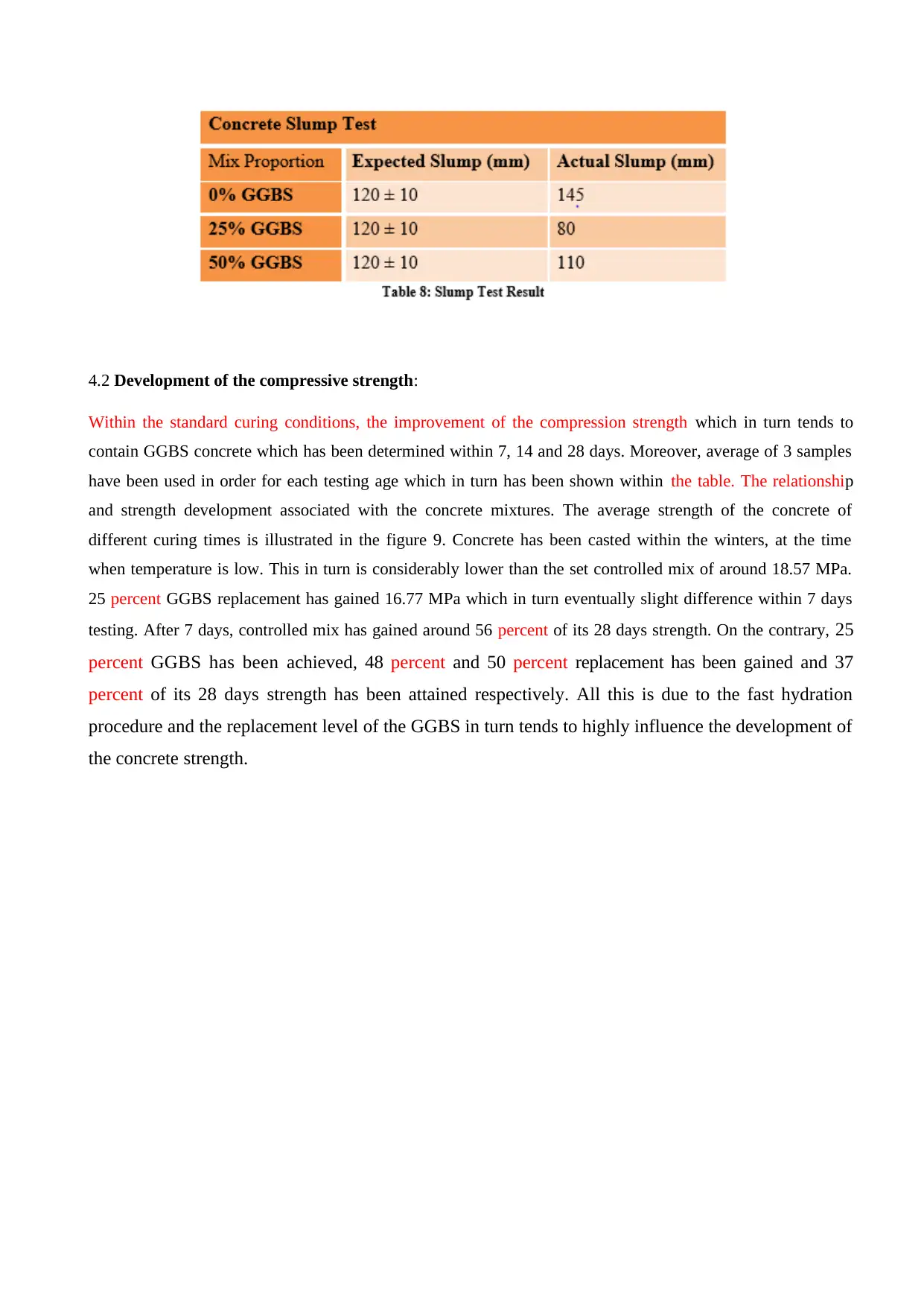
4.2 Development of the compressive strength:
Within the standard curing conditions, the improvement of the compression strength which in turn tends to
contain GGBS concrete which has been determined within 7, 14 and 28 days. Moreover, average of 3 samples
have been used in order for each testing age which in turn has been shown within the table. The relationship
and strength development associated with the concrete mixtures. The average strength of the concrete of
different curing times is illustrated in the figure 9. Concrete has been casted within the winters, at the time
when temperature is low. This in turn is considerably lower than the set controlled mix of around 18.57 MPa.
25 percent GGBS replacement has gained 16.77 MPa which in turn eventually slight difference within 7 days
testing. After 7 days, controlled mix has gained around 56 percent of its 28 days strength. On the contrary, 25
percent GGBS has been achieved, 48 percent and 50 percent replacement has been gained and 37
percent of its 28 days strength has been attained respectively. All this is due to the fast hydration
procedure and the replacement level of the GGBS in turn tends to highly influence the development of
the concrete strength.
Within the standard curing conditions, the improvement of the compression strength which in turn tends to
contain GGBS concrete which has been determined within 7, 14 and 28 days. Moreover, average of 3 samples
have been used in order for each testing age which in turn has been shown within the table. The relationship
and strength development associated with the concrete mixtures. The average strength of the concrete of
different curing times is illustrated in the figure 9. Concrete has been casted within the winters, at the time
when temperature is low. This in turn is considerably lower than the set controlled mix of around 18.57 MPa.
25 percent GGBS replacement has gained 16.77 MPa which in turn eventually slight difference within 7 days
testing. After 7 days, controlled mix has gained around 56 percent of its 28 days strength. On the contrary, 25
percent GGBS has been achieved, 48 percent and 50 percent replacement has been gained and 37
percent of its 28 days strength has been attained respectively. All this is due to the fast hydration
procedure and the replacement level of the GGBS in turn tends to highly influence the development of
the concrete strength.

After the 14 days testing, 25 percent GGBS concrete has been gained with the average strength of 27.63 MPa.
Among which 50 percent has achieved 19.40 MPa and the controlled mix concrete which in turn has achieved
27.53 MPa. At day 14th, the strength of the controlled mix has attained the 83 percent. 25 percent GGBS has
gained 79 percent and the 50 percent GGBS has gained 75 percent of its 28 days strength has been significantly
risen and in turn also achieved GGBS as 25 percent replacement.
At 28th day, 25 percent GGBS replacement has attained high degree of strength than the controlled mix. 50
percent replacement in turn also shows high degree of significant increase which in turn has been illustrated
Among which 50 percent has achieved 19.40 MPa and the controlled mix concrete which in turn has achieved
27.53 MPa. At day 14th, the strength of the controlled mix has attained the 83 percent. 25 percent GGBS has
gained 79 percent and the 50 percent GGBS has gained 75 percent of its 28 days strength has been significantly
risen and in turn also achieved GGBS as 25 percent replacement.
At 28th day, 25 percent GGBS replacement has attained high degree of strength than the controlled mix. 50
percent replacement in turn also shows high degree of significant increase which in turn has been illustrated

within figure 8 and figure 9. After the completion of 28 days, there seems to be continuous development in the
strength of the GGBS. The GGBS in concrete tends to attain long term strength which in turn is vital. The
lower degree of the initial strength in GGBs results in major disadvantage within the fast track construction. As
supported by the literature review, 50 percent GGBS replacement after the 28 days tends to attain high degree
of strength as compared to the Portland cement concrete.
strength of the GGBS. The GGBS in concrete tends to attain long term strength which in turn is vital. The
lower degree of the initial strength in GGBs results in major disadvantage within the fast track construction. As
supported by the literature review, 50 percent GGBS replacement after the 28 days tends to attain high degree
of strength as compared to the Portland cement concrete.
Paraphrase This Document
Need a fresh take? Get an instant paraphrase of this document with our AI Paraphraser
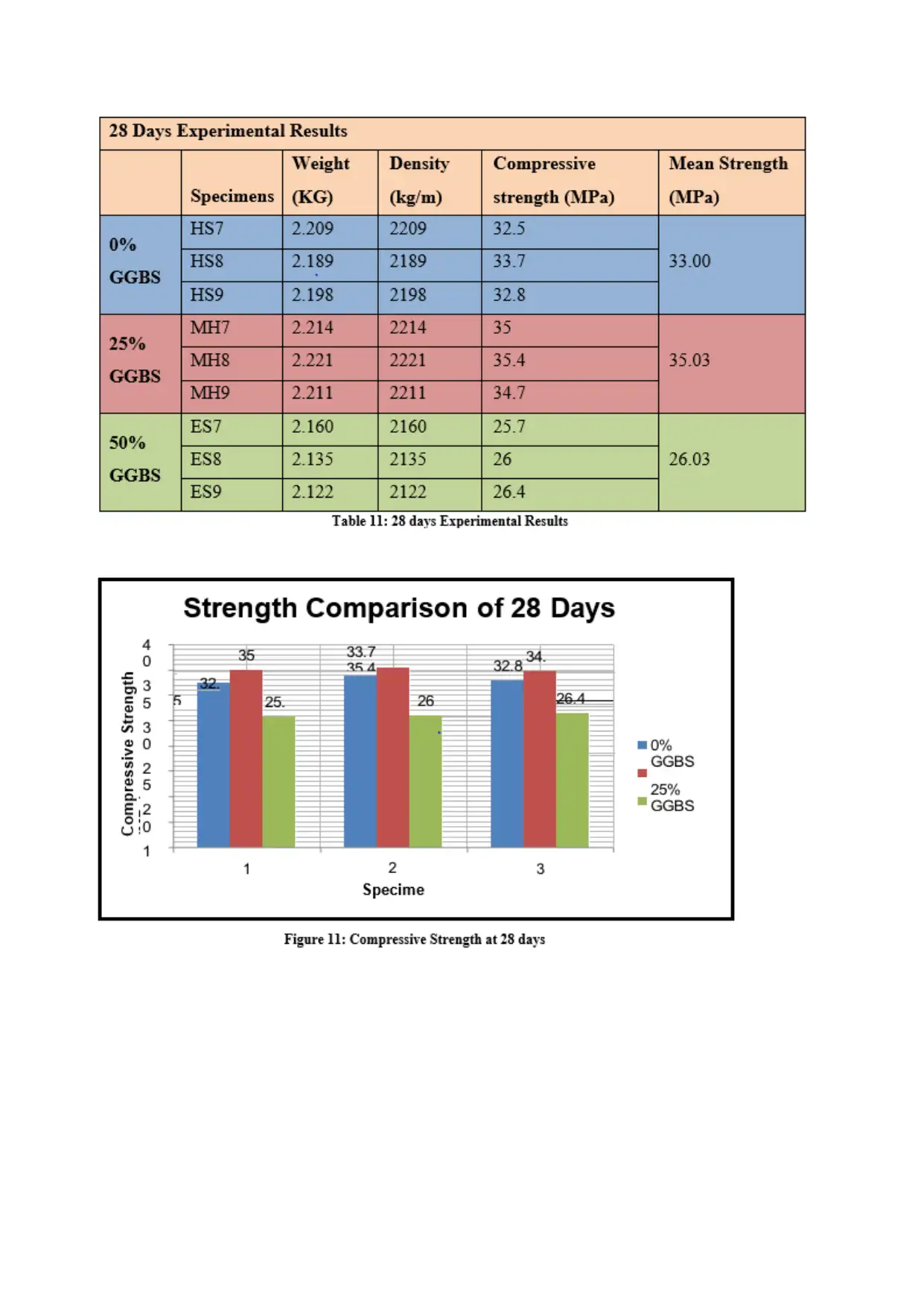

CHAPTER 5: CONCLUSIONS
Casting of the concrete is also done by the usage of varied percentage of the GGBS and also tends to
compare various sets of results to the Portland cement concrete. Moreover, concrete, has been used widely
across the globe. One of the key necessary element associated with the concrete is mainly linked with the
Portland cement (Saranya, Nagarajan and Shashikala, 2020). It has been examined that, the manufacturing
of the Portland cement tends to require high amount of energy which in turn eventually emits carbon dioxide
within the environment. The production process is also highly expensive. In order to improve the various
environmental impact of the cost and concrete, use of Pozzolonic material is very crucial. This is very vital for
the replacement of the cements which in turn tends to largely reduce the cost and in turn helps in improving the
environmental efficiency of the concrete.
a.) GGBS is considered to be one of the most sustainable waste material which in turn is produced by the
iron industry. Inclusion of the GGBS within the concrete helps in reducing the emission of the carbon
dioxide, greenhouse gases, embodied energy. It is also very useful in reducing the effect of the heat
within the process of hydration. 50 percent replacement of the GGBS in turn tends to reduce 40
percent of the emission of carbon dioxide.
b.) Specimens associated with the hardened concrete density is usually prepared by the controlled mix
which in turn is usually based on the GGBS replacement. This in turn tends to have the similar amount
Casting of the concrete is also done by the usage of varied percentage of the GGBS and also tends to
compare various sets of results to the Portland cement concrete. Moreover, concrete, has been used widely
across the globe. One of the key necessary element associated with the concrete is mainly linked with the
Portland cement (Saranya, Nagarajan and Shashikala, 2020). It has been examined that, the manufacturing
of the Portland cement tends to require high amount of energy which in turn eventually emits carbon dioxide
within the environment. The production process is also highly expensive. In order to improve the various
environmental impact of the cost and concrete, use of Pozzolonic material is very crucial. This is very vital for
the replacement of the cements which in turn tends to largely reduce the cost and in turn helps in improving the
environmental efficiency of the concrete.
a.) GGBS is considered to be one of the most sustainable waste material which in turn is produced by the
iron industry. Inclusion of the GGBS within the concrete helps in reducing the emission of the carbon
dioxide, greenhouse gases, embodied energy. It is also very useful in reducing the effect of the heat
within the process of hydration. 50 percent replacement of the GGBS in turn tends to reduce 40
percent of the emission of carbon dioxide.
b.) Specimens associated with the hardened concrete density is usually prepared by the controlled mix
which in turn is usually based on the GGBS replacement. This in turn tends to have the similar amount
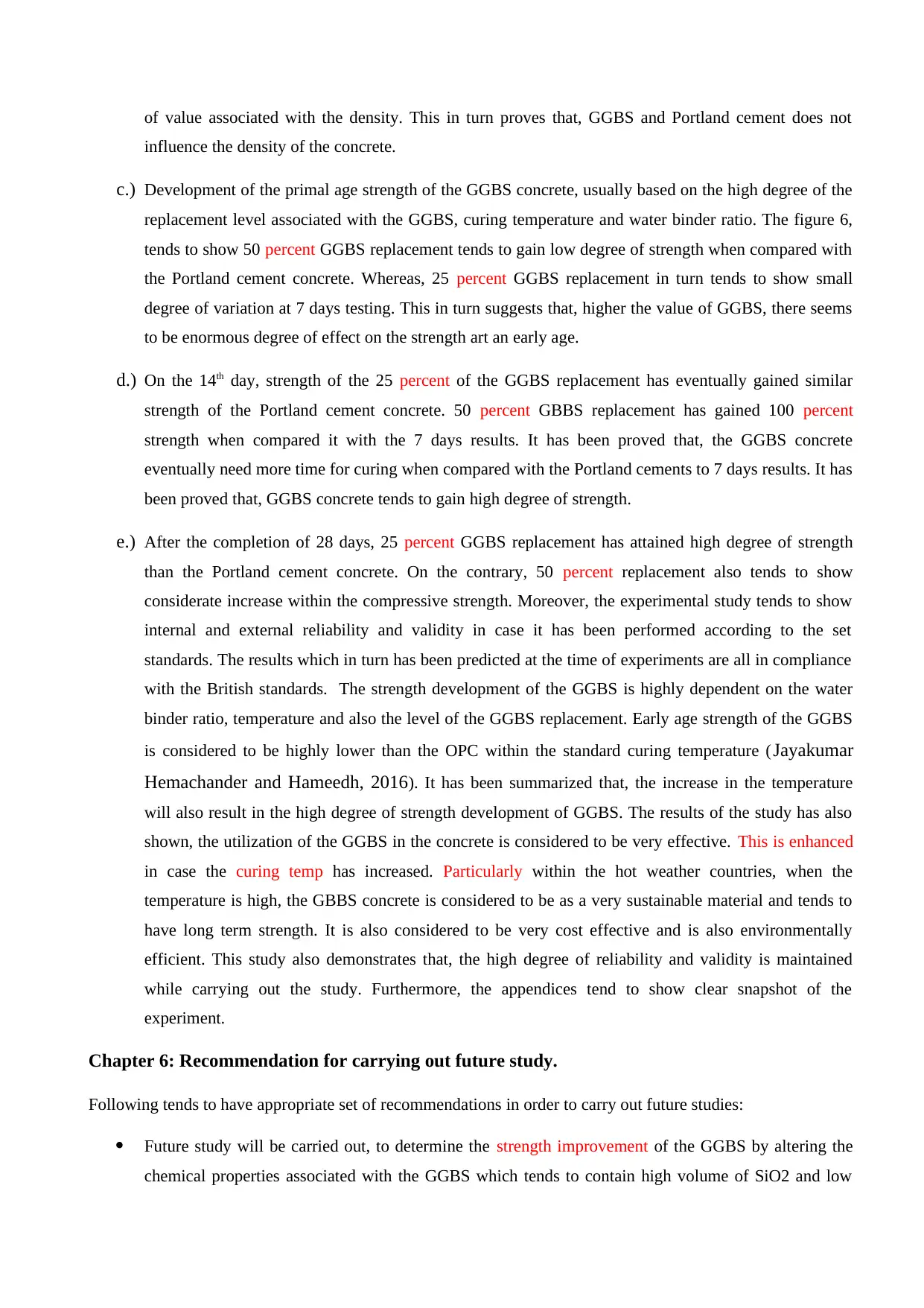
of value associated with the density. This in turn proves that, GGBS and Portland cement does not
influence the density of the concrete.
c.) Development of the primal age strength of the GGBS concrete, usually based on the high degree of the
replacement level associated with the GGBS, curing temperature and water binder ratio. The figure 6,
tends to show 50 percent GGBS replacement tends to gain low degree of strength when compared with
the Portland cement concrete. Whereas, 25 percent GGBS replacement in turn tends to show small
degree of variation at 7 days testing. This in turn suggests that, higher the value of GGBS, there seems
to be enormous degree of effect on the strength art an early age.
d.) On the 14th day, strength of the 25 percent of the GGBS replacement has eventually gained similar
strength of the Portland cement concrete. 50 percent GBBS replacement has gained 100 percent
strength when compared it with the 7 days results. It has been proved that, the GGBS concrete
eventually need more time for curing when compared with the Portland cements to 7 days results. It has
been proved that, GGBS concrete tends to gain high degree of strength.
e.) After the completion of 28 days, 25 percent GGBS replacement has attained high degree of strength
than the Portland cement concrete. On the contrary, 50 percent replacement also tends to show
considerate increase within the compressive strength. Moreover, the experimental study tends to show
internal and external reliability and validity in case it has been performed according to the set
standards. The results which in turn has been predicted at the time of experiments are all in compliance
with the British standards. The strength development of the GGBS is highly dependent on the water
binder ratio, temperature and also the level of the GGBS replacement. Early age strength of the GGBS
is considered to be highly lower than the OPC within the standard curing temperature (Jayakumar
Hemachander and Hameedh, 2016). It has been summarized that, the increase in the temperature
will also result in the high degree of strength development of GGBS. The results of the study has also
shown, the utilization of the GGBS in the concrete is considered to be very effective. This is enhanced
in case the curing temp has increased. Particularly within the hot weather countries, when the
temperature is high, the GBBS concrete is considered to be as a very sustainable material and tends to
have long term strength. It is also considered to be very cost effective and is also environmentally
efficient. This study also demonstrates that, the high degree of reliability and validity is maintained
while carrying out the study. Furthermore, the appendices tend to show clear snapshot of the
experiment.
Chapter 6: Recommendation for carrying out future study.
Following tends to have appropriate set of recommendations in order to carry out future studies:
Future study will be carried out, to determine the strength improvement of the GGBS by altering the
chemical properties associated with the GGBS which tends to contain high volume of SiO2 and low
influence the density of the concrete.
c.) Development of the primal age strength of the GGBS concrete, usually based on the high degree of the
replacement level associated with the GGBS, curing temperature and water binder ratio. The figure 6,
tends to show 50 percent GGBS replacement tends to gain low degree of strength when compared with
the Portland cement concrete. Whereas, 25 percent GGBS replacement in turn tends to show small
degree of variation at 7 days testing. This in turn suggests that, higher the value of GGBS, there seems
to be enormous degree of effect on the strength art an early age.
d.) On the 14th day, strength of the 25 percent of the GGBS replacement has eventually gained similar
strength of the Portland cement concrete. 50 percent GBBS replacement has gained 100 percent
strength when compared it with the 7 days results. It has been proved that, the GGBS concrete
eventually need more time for curing when compared with the Portland cements to 7 days results. It has
been proved that, GGBS concrete tends to gain high degree of strength.
e.) After the completion of 28 days, 25 percent GGBS replacement has attained high degree of strength
than the Portland cement concrete. On the contrary, 50 percent replacement also tends to show
considerate increase within the compressive strength. Moreover, the experimental study tends to show
internal and external reliability and validity in case it has been performed according to the set
standards. The results which in turn has been predicted at the time of experiments are all in compliance
with the British standards. The strength development of the GGBS is highly dependent on the water
binder ratio, temperature and also the level of the GGBS replacement. Early age strength of the GGBS
is considered to be highly lower than the OPC within the standard curing temperature (Jayakumar
Hemachander and Hameedh, 2016). It has been summarized that, the increase in the temperature
will also result in the high degree of strength development of GGBS. The results of the study has also
shown, the utilization of the GGBS in the concrete is considered to be very effective. This is enhanced
in case the curing temp has increased. Particularly within the hot weather countries, when the
temperature is high, the GBBS concrete is considered to be as a very sustainable material and tends to
have long term strength. It is also considered to be very cost effective and is also environmentally
efficient. This study also demonstrates that, the high degree of reliability and validity is maintained
while carrying out the study. Furthermore, the appendices tend to show clear snapshot of the
experiment.
Chapter 6: Recommendation for carrying out future study.
Following tends to have appropriate set of recommendations in order to carry out future studies:
Future study will be carried out, to determine the strength improvement of the GGBS by altering the
chemical properties associated with the GGBS which tends to contain high volume of SiO2 and low
Secure Best Marks with AI Grader
Need help grading? Try our AI Grader for instant feedback on your assignments.
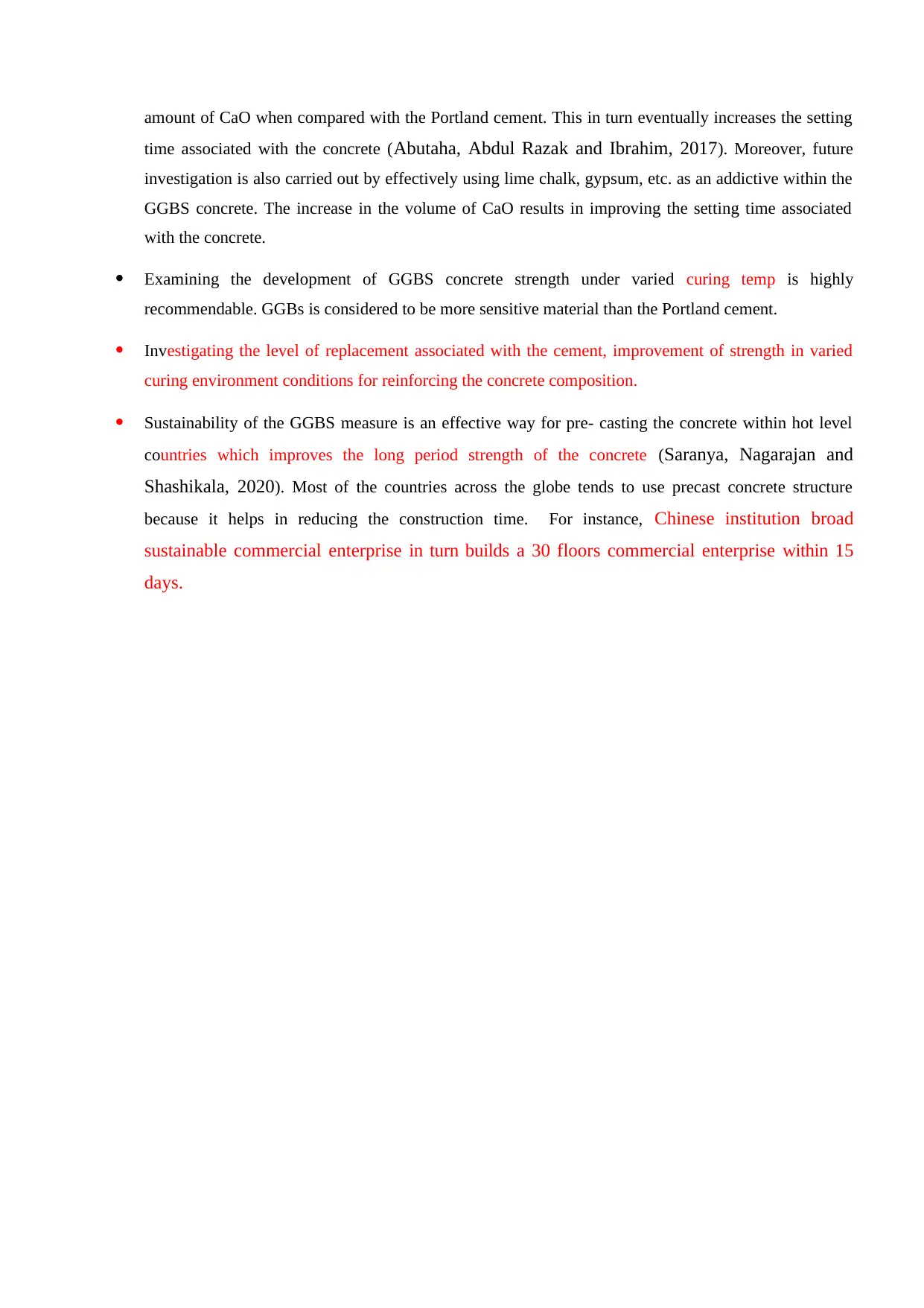
amount of CaO when compared with the Portland cement. This in turn eventually increases the setting
time associated with the concrete (Abutaha, Abdul Razak and Ibrahim, 2017). Moreover, future
investigation is also carried out by effectively using lime chalk, gypsum, etc. as an addictive within the
GGBS concrete. The increase in the volume of CaO results in improving the setting time associated
with the concrete.
Examining the development of GGBS concrete strength under varied curing temp is highly
recommendable. GGBs is considered to be more sensitive material than the Portland cement.
Investigating the level of replacement associated with the cement, improvement of strength in varied
curing environment conditions for reinforcing the concrete composition.
Sustainability of the GGBS measure is an effective way for pre- casting the concrete within hot level
countries which improves the long period strength of the concrete (Saranya, Nagarajan and
Shashikala, 2020). Most of the countries across the globe tends to use precast concrete structure
because it helps in reducing the construction time. For instance, Chinese institution broad
sustainable commercial enterprise in turn builds a 30 floors commercial enterprise within 15
days.
time associated with the concrete (Abutaha, Abdul Razak and Ibrahim, 2017). Moreover, future
investigation is also carried out by effectively using lime chalk, gypsum, etc. as an addictive within the
GGBS concrete. The increase in the volume of CaO results in improving the setting time associated
with the concrete.
Examining the development of GGBS concrete strength under varied curing temp is highly
recommendable. GGBs is considered to be more sensitive material than the Portland cement.
Investigating the level of replacement associated with the cement, improvement of strength in varied
curing environment conditions for reinforcing the concrete composition.
Sustainability of the GGBS measure is an effective way for pre- casting the concrete within hot level
countries which improves the long period strength of the concrete (Saranya, Nagarajan and
Shashikala, 2020). Most of the countries across the globe tends to use precast concrete structure
because it helps in reducing the construction time. For instance, Chinese institution broad
sustainable commercial enterprise in turn builds a 30 floors commercial enterprise within 15
days.
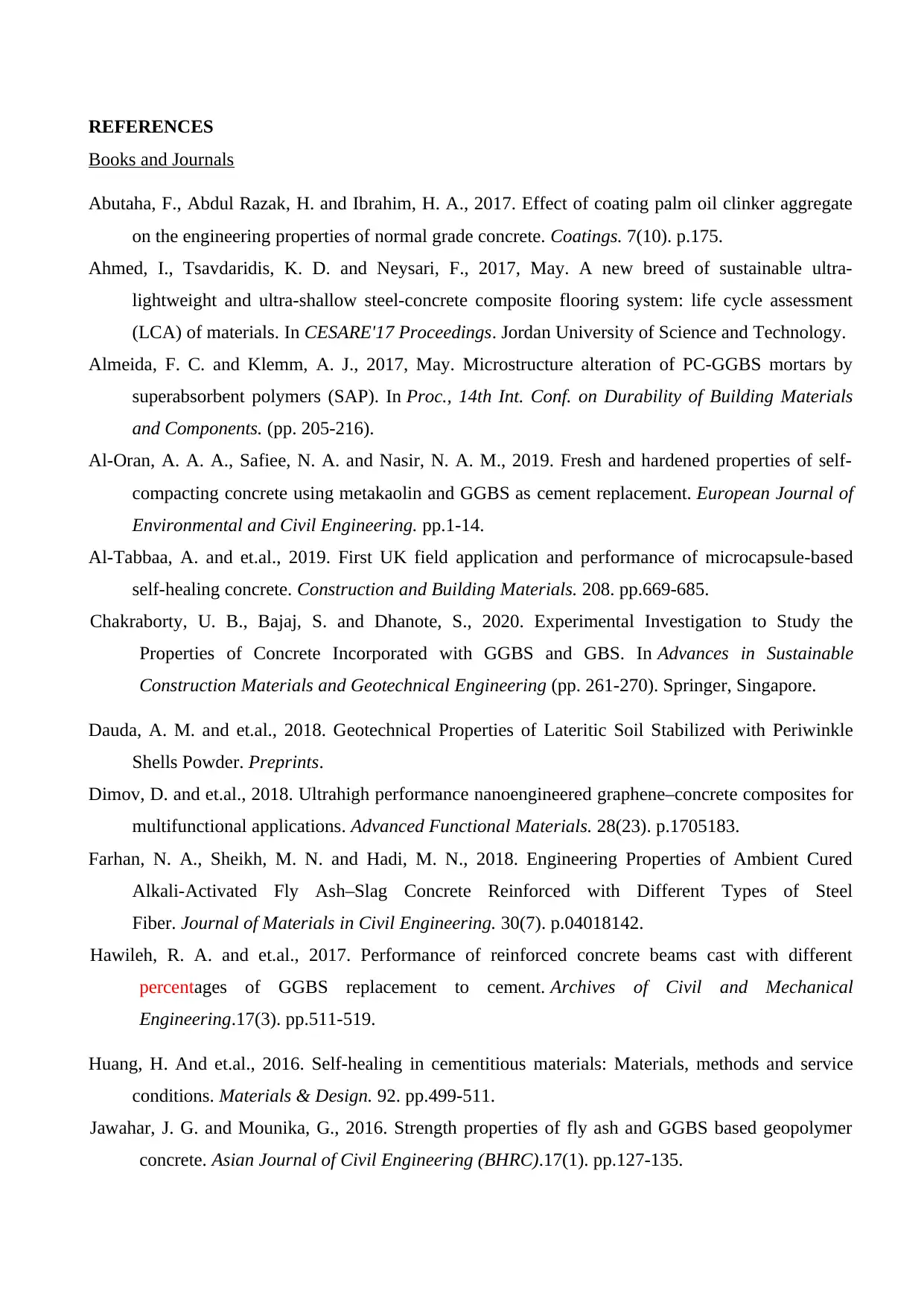
REFERENCES
Books and Journals
Abutaha, F., Abdul Razak, H. and Ibrahim, H. A., 2017. Effect of coating palm oil clinker aggregate
on the engineering properties of normal grade concrete. Coatings. 7(10). p.175.
Ahmed, I., Tsavdaridis, K. D. and Neysari, F., 2017, May. A new breed of sustainable ultra-
lightweight and ultra-shallow steel-concrete composite flooring system: life cycle assessment
(LCA) of materials. In CESARE'17 Proceedings. Jordan University of Science and Technology.
Almeida, F. C. and Klemm, A. J., 2017, May. Microstructure alteration of PC-GGBS mortars by
superabsorbent polymers (SAP). In Proc., 14th Int. Conf. on Durability of Building Materials
and Components. (pp. 205-216).
Al-Oran, A. A. A., Safiee, N. A. and Nasir, N. A. M., 2019. Fresh and hardened properties of self-
compacting concrete using metakaolin and GGBS as cement replacement. European Journal of
Environmental and Civil Engineering. pp.1-14.
Al-Tabbaa, A. and et.al., 2019. First UK field application and performance of microcapsule-based
self-healing concrete. Construction and Building Materials. 208. pp.669-685.
Chakraborty, U. B., Bajaj, S. and Dhanote, S., 2020. Experimental Investigation to Study the
Properties of Concrete Incorporated with GGBS and GBS. In Advances in Sustainable
Construction Materials and Geotechnical Engineering (pp. 261-270). Springer, Singapore.
Dauda, A. M. and et.al., 2018. Geotechnical Properties of Lateritic Soil Stabilized with Periwinkle
Shells Powder. Preprints.
Dimov, D. and et.al., 2018. Ultrahigh performance nanoengineered graphene–concrete composites for
multifunctional applications. Advanced Functional Materials. 28(23). p.1705183.
Farhan, N. A., Sheikh, M. N. and Hadi, M. N., 2018. Engineering Properties of Ambient Cured
Alkali-Activated Fly Ash–Slag Concrete Reinforced with Different Types of Steel
Fiber. Journal of Materials in Civil Engineering. 30(7). p.04018142.
Hawileh, R. A. and et.al., 2017. Performance of reinforced concrete beams cast with different
percentages of GGBS replacement to cement. Archives of Civil and Mechanical
Engineering.17(3). pp.511-519.
Huang, H. And et.al., 2016. Self-healing in cementitious materials: Materials, methods and service
conditions. Materials & Design. 92. pp.499-511.
Jawahar, J. G. and Mounika, G., 2016. Strength properties of fly ash and GGBS based geopolymer
concrete. Asian Journal of Civil Engineering (BHRC).17(1). pp.127-135.
Books and Journals
Abutaha, F., Abdul Razak, H. and Ibrahim, H. A., 2017. Effect of coating palm oil clinker aggregate
on the engineering properties of normal grade concrete. Coatings. 7(10). p.175.
Ahmed, I., Tsavdaridis, K. D. and Neysari, F., 2017, May. A new breed of sustainable ultra-
lightweight and ultra-shallow steel-concrete composite flooring system: life cycle assessment
(LCA) of materials. In CESARE'17 Proceedings. Jordan University of Science and Technology.
Almeida, F. C. and Klemm, A. J., 2017, May. Microstructure alteration of PC-GGBS mortars by
superabsorbent polymers (SAP). In Proc., 14th Int. Conf. on Durability of Building Materials
and Components. (pp. 205-216).
Al-Oran, A. A. A., Safiee, N. A. and Nasir, N. A. M., 2019. Fresh and hardened properties of self-
compacting concrete using metakaolin and GGBS as cement replacement. European Journal of
Environmental and Civil Engineering. pp.1-14.
Al-Tabbaa, A. and et.al., 2019. First UK field application and performance of microcapsule-based
self-healing concrete. Construction and Building Materials. 208. pp.669-685.
Chakraborty, U. B., Bajaj, S. and Dhanote, S., 2020. Experimental Investigation to Study the
Properties of Concrete Incorporated with GGBS and GBS. In Advances in Sustainable
Construction Materials and Geotechnical Engineering (pp. 261-270). Springer, Singapore.
Dauda, A. M. and et.al., 2018. Geotechnical Properties of Lateritic Soil Stabilized with Periwinkle
Shells Powder. Preprints.
Dimov, D. and et.al., 2018. Ultrahigh performance nanoengineered graphene–concrete composites for
multifunctional applications. Advanced Functional Materials. 28(23). p.1705183.
Farhan, N. A., Sheikh, M. N. and Hadi, M. N., 2018. Engineering Properties of Ambient Cured
Alkali-Activated Fly Ash–Slag Concrete Reinforced with Different Types of Steel
Fiber. Journal of Materials in Civil Engineering. 30(7). p.04018142.
Hawileh, R. A. and et.al., 2017. Performance of reinforced concrete beams cast with different
percentages of GGBS replacement to cement. Archives of Civil and Mechanical
Engineering.17(3). pp.511-519.
Huang, H. And et.al., 2016. Self-healing in cementitious materials: Materials, methods and service
conditions. Materials & Design. 92. pp.499-511.
Jawahar, J. G. and Mounika, G., 2016. Strength properties of fly ash and GGBS based geopolymer
concrete. Asian Journal of Civil Engineering (BHRC).17(1). pp.127-135.

Jayakumar, S., Hemachander, J. and Hameedh, J. M., 2016. Experimental study on properties of
rammed earth blended with GGBS and silica flume. IJRET. 5(5). pp.295-297.
Kumar, G. R., Bhardwaj, A. and Sharma, U. K., 2018. Cavitation resistance of concrete containing
different material properties. Advances in concrete construction. 6(1). p.15.
Lee, S. W. and et.al., 2019. Mechanical Performances of Green Engineered Cementitious Composites
Incorporating Various Types of Sand. In Key Engineering Materials (Vol. 821. pp. 512-517).
Trans Tech Publications Ltd.
Lekhaz, D. And et.al., 2016. A Study on Bituminous Concrete Mix with Cement, GGBS, Brick Dust
as a Filler. International Journal of Engineering science and Computing. 6 (10). 2771, 2775.
Li, X. and et.al., 2020. A Comparative Study on the Influence of Supplementary Cementitious
Materials on Marine Concrete. Journal of Testing and Evaluation. 48(3).
Mhatre, D. S., 2018. Effect of partial replacement of GGBS slag as fine aggregate and fly ash as
cement on strength of concrete. International Journal for Emerging Research and
Development. 1(6). pp.26-32.
Murphy, C., 2018. Designing bridges for manufacture and assembly: joining technologies for precast
concrete components. The Structural Engineer: journal of the Institution of Structural
Engineer. 96(11). pp.11-16.
O’Shea, M., Gray, K. and Murphy, J., 2019. An Investigation into the Suitability of GGBS and OPC
as Low percentage Single-Component Binders for the Stabilisation and Solidification of
Harbour Dredge Material Mildly Contaminated with Metals. Journal of Marine Science and
Engineering. 7(4). p.106.
Pasupuleti, M. K. and Rajasekhar, K., 2018. Experimental Study of Properties of Concrete using
GGBS and M-Sand with Addition of Basalt Fibre. i-Manager's Journal on Structural
Engineering. 7(4). p.15.
Pavía, S. and Aly, M., 2016. Influence of aggregate and supplementary cementitious materials on the
properties of hydrated lime (CL90s) mortars. Materiales de Construcción. 66(324). p.104.
Phanikumar, B. R. and Nagaraju, T. V., 2018. Engineering behaviour of expansive clays blended with
cement and GGBS. Proceedings of the Institution of Civil Engineers-Ground
Improvement. 171(3). pp.167-173.
Rao, S. K., Sravana, P. and Rao, T. C., 2016. Abrasion resistance and mechanical properties of Roller
Compacted Concrete with GGBS. Construction and Building Materials. 114. pp.925-933.
Samson, G., Cyr, M. and Gao, X. X., 2017. Thermomechanical performance of blended metakaolin-
GGBS alkali-activated foam concrete. Construction and Building Materials.157. pp.982-993.
rammed earth blended with GGBS and silica flume. IJRET. 5(5). pp.295-297.
Kumar, G. R., Bhardwaj, A. and Sharma, U. K., 2018. Cavitation resistance of concrete containing
different material properties. Advances in concrete construction. 6(1). p.15.
Lee, S. W. and et.al., 2019. Mechanical Performances of Green Engineered Cementitious Composites
Incorporating Various Types of Sand. In Key Engineering Materials (Vol. 821. pp. 512-517).
Trans Tech Publications Ltd.
Lekhaz, D. And et.al., 2016. A Study on Bituminous Concrete Mix with Cement, GGBS, Brick Dust
as a Filler. International Journal of Engineering science and Computing. 6 (10). 2771, 2775.
Li, X. and et.al., 2020. A Comparative Study on the Influence of Supplementary Cementitious
Materials on Marine Concrete. Journal of Testing and Evaluation. 48(3).
Mhatre, D. S., 2018. Effect of partial replacement of GGBS slag as fine aggregate and fly ash as
cement on strength of concrete. International Journal for Emerging Research and
Development. 1(6). pp.26-32.
Murphy, C., 2018. Designing bridges for manufacture and assembly: joining technologies for precast
concrete components. The Structural Engineer: journal of the Institution of Structural
Engineer. 96(11). pp.11-16.
O’Shea, M., Gray, K. and Murphy, J., 2019. An Investigation into the Suitability of GGBS and OPC
as Low percentage Single-Component Binders for the Stabilisation and Solidification of
Harbour Dredge Material Mildly Contaminated with Metals. Journal of Marine Science and
Engineering. 7(4). p.106.
Pasupuleti, M. K. and Rajasekhar, K., 2018. Experimental Study of Properties of Concrete using
GGBS and M-Sand with Addition of Basalt Fibre. i-Manager's Journal on Structural
Engineering. 7(4). p.15.
Pavía, S. and Aly, M., 2016. Influence of aggregate and supplementary cementitious materials on the
properties of hydrated lime (CL90s) mortars. Materiales de Construcción. 66(324). p.104.
Phanikumar, B. R. and Nagaraju, T. V., 2018. Engineering behaviour of expansive clays blended with
cement and GGBS. Proceedings of the Institution of Civil Engineers-Ground
Improvement. 171(3). pp.167-173.
Rao, S. K., Sravana, P. and Rao, T. C., 2016. Abrasion resistance and mechanical properties of Roller
Compacted Concrete with GGBS. Construction and Building Materials. 114. pp.925-933.
Samson, G., Cyr, M. and Gao, X. X., 2017. Thermomechanical performance of blended metakaolin-
GGBS alkali-activated foam concrete. Construction and Building Materials.157. pp.982-993.
Paraphrase This Document
Need a fresh take? Get an instant paraphrase of this document with our AI Paraphraser
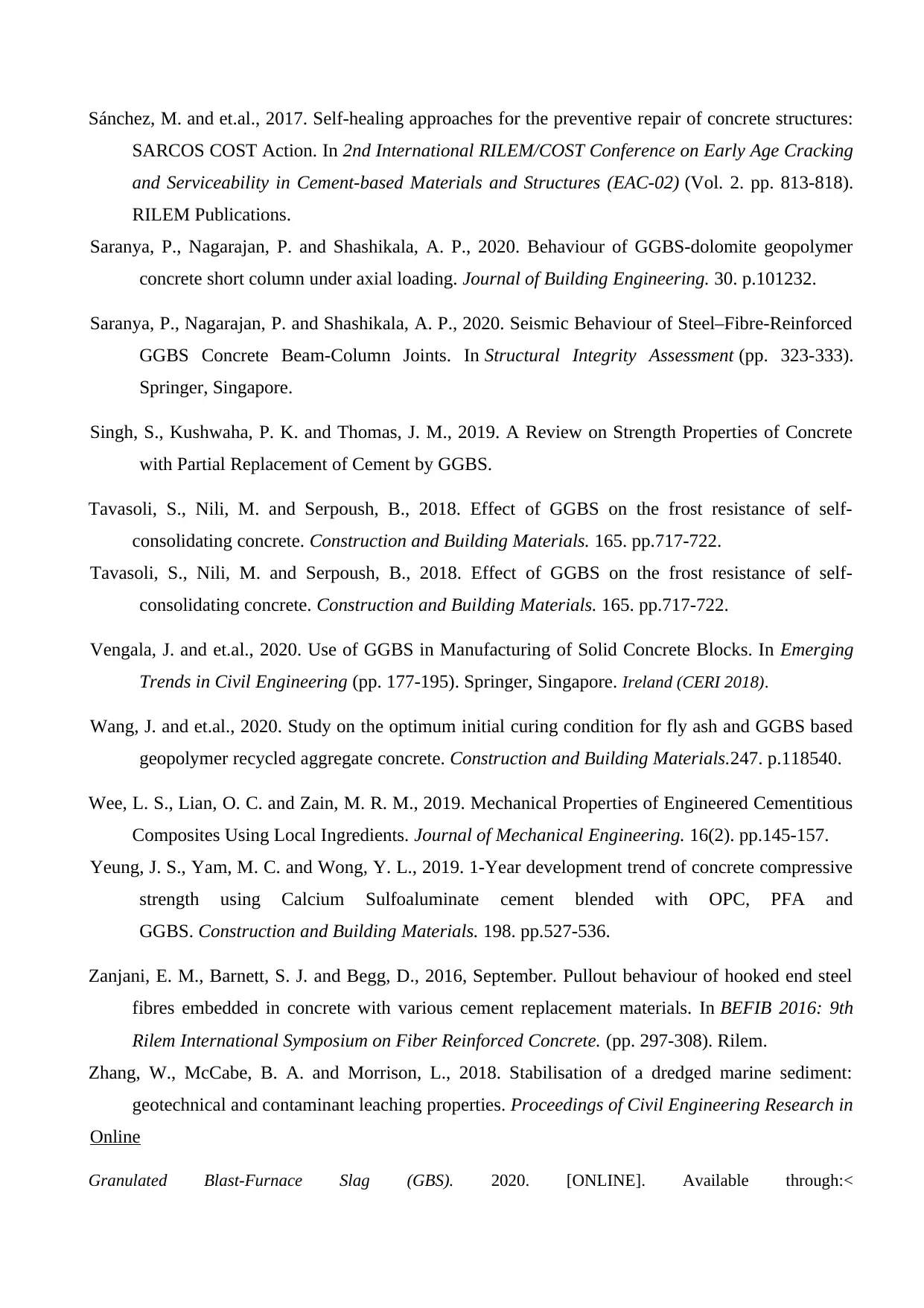
Sánchez, M. and et.al., 2017. Self-healing approaches for the preventive repair of concrete structures:
SARCOS COST Action. In 2nd International RILEM/COST Conference on Early Age Cracking
and Serviceability in Cement-based Materials and Structures (EAC-02) (Vol. 2. pp. 813-818).
RILEM Publications.
Saranya, P., Nagarajan, P. and Shashikala, A. P., 2020. Behaviour of GGBS-dolomite geopolymer
concrete short column under axial loading. Journal of Building Engineering. 30. p.101232.
Saranya, P., Nagarajan, P. and Shashikala, A. P., 2020. Seismic Behaviour of Steel–Fibre-Reinforced
GGBS Concrete Beam-Column Joints. In Structural Integrity Assessment (pp. 323-333).
Springer, Singapore.
Singh, S., Kushwaha, P. K. and Thomas, J. M., 2019. A Review on Strength Properties of Concrete
with Partial Replacement of Cement by GGBS.
Tavasoli, S., Nili, M. and Serpoush, B., 2018. Effect of GGBS on the frost resistance of self-
consolidating concrete. Construction and Building Materials. 165. pp.717-722.
Tavasoli, S., Nili, M. and Serpoush, B., 2018. Effect of GGBS on the frost resistance of self-
consolidating concrete. Construction and Building Materials. 165. pp.717-722.
Vengala, J. and et.al., 2020. Use of GGBS in Manufacturing of Solid Concrete Blocks. In Emerging
Trends in Civil Engineering (pp. 177-195). Springer, Singapore. Ireland (CERI 2018).
Wang, J. and et.al., 2020. Study on the optimum initial curing condition for fly ash and GGBS based
geopolymer recycled aggregate concrete. Construction and Building Materials.247. p.118540.
Wee, L. S., Lian, O. C. and Zain, M. R. M., 2019. Mechanical Properties of Engineered Cementitious
Composites Using Local Ingredients. Journal of Mechanical Engineering. 16(2). pp.145-157.
Yeung, J. S., Yam, M. C. and Wong, Y. L., 2019. 1-Year development trend of concrete compressive
strength using Calcium Sulfoaluminate cement blended with OPC, PFA and
GGBS. Construction and Building Materials. 198. pp.527-536.
Zanjani, E. M., Barnett, S. J. and Begg, D., 2016, September. Pullout behaviour of hooked end steel
fibres embedded in concrete with various cement replacement materials. In BEFIB 2016: 9th
Rilem International Symposium on Fiber Reinforced Concrete. (pp. 297-308). Rilem.
Zhang, W., McCabe, B. A. and Morrison, L., 2018. Stabilisation of a dredged marine sediment:
geotechnical and contaminant leaching properties. Proceedings of Civil Engineering Research in
Online
Granulated Blast-Furnace Slag (GBS). 2020. [ONLINE]. Available through:<
SARCOS COST Action. In 2nd International RILEM/COST Conference on Early Age Cracking
and Serviceability in Cement-based Materials and Structures (EAC-02) (Vol. 2. pp. 813-818).
RILEM Publications.
Saranya, P., Nagarajan, P. and Shashikala, A. P., 2020. Behaviour of GGBS-dolomite geopolymer
concrete short column under axial loading. Journal of Building Engineering. 30. p.101232.
Saranya, P., Nagarajan, P. and Shashikala, A. P., 2020. Seismic Behaviour of Steel–Fibre-Reinforced
GGBS Concrete Beam-Column Joints. In Structural Integrity Assessment (pp. 323-333).
Springer, Singapore.
Singh, S., Kushwaha, P. K. and Thomas, J. M., 2019. A Review on Strength Properties of Concrete
with Partial Replacement of Cement by GGBS.
Tavasoli, S., Nili, M. and Serpoush, B., 2018. Effect of GGBS on the frost resistance of self-
consolidating concrete. Construction and Building Materials. 165. pp.717-722.
Tavasoli, S., Nili, M. and Serpoush, B., 2018. Effect of GGBS on the frost resistance of self-
consolidating concrete. Construction and Building Materials. 165. pp.717-722.
Vengala, J. and et.al., 2020. Use of GGBS in Manufacturing of Solid Concrete Blocks. In Emerging
Trends in Civil Engineering (pp. 177-195). Springer, Singapore. Ireland (CERI 2018).
Wang, J. and et.al., 2020. Study on the optimum initial curing condition for fly ash and GGBS based
geopolymer recycled aggregate concrete. Construction and Building Materials.247. p.118540.
Wee, L. S., Lian, O. C. and Zain, M. R. M., 2019. Mechanical Properties of Engineered Cementitious
Composites Using Local Ingredients. Journal of Mechanical Engineering. 16(2). pp.145-157.
Yeung, J. S., Yam, M. C. and Wong, Y. L., 2019. 1-Year development trend of concrete compressive
strength using Calcium Sulfoaluminate cement blended with OPC, PFA and
GGBS. Construction and Building Materials. 198. pp.527-536.
Zanjani, E. M., Barnett, S. J. and Begg, D., 2016, September. Pullout behaviour of hooked end steel
fibres embedded in concrete with various cement replacement materials. In BEFIB 2016: 9th
Rilem International Symposium on Fiber Reinforced Concrete. (pp. 297-308). Rilem.
Zhang, W., McCabe, B. A. and Morrison, L., 2018. Stabilisation of a dredged marine sediment:
geotechnical and contaminant leaching properties. Proceedings of Civil Engineering Research in
Online
Granulated Blast-Furnace Slag (GBS). 2020. [ONLINE]. Available through:<

https://www.indiamart.com/proddetail/granulated-blast-furnace-slag-gbs-5012674673.html>
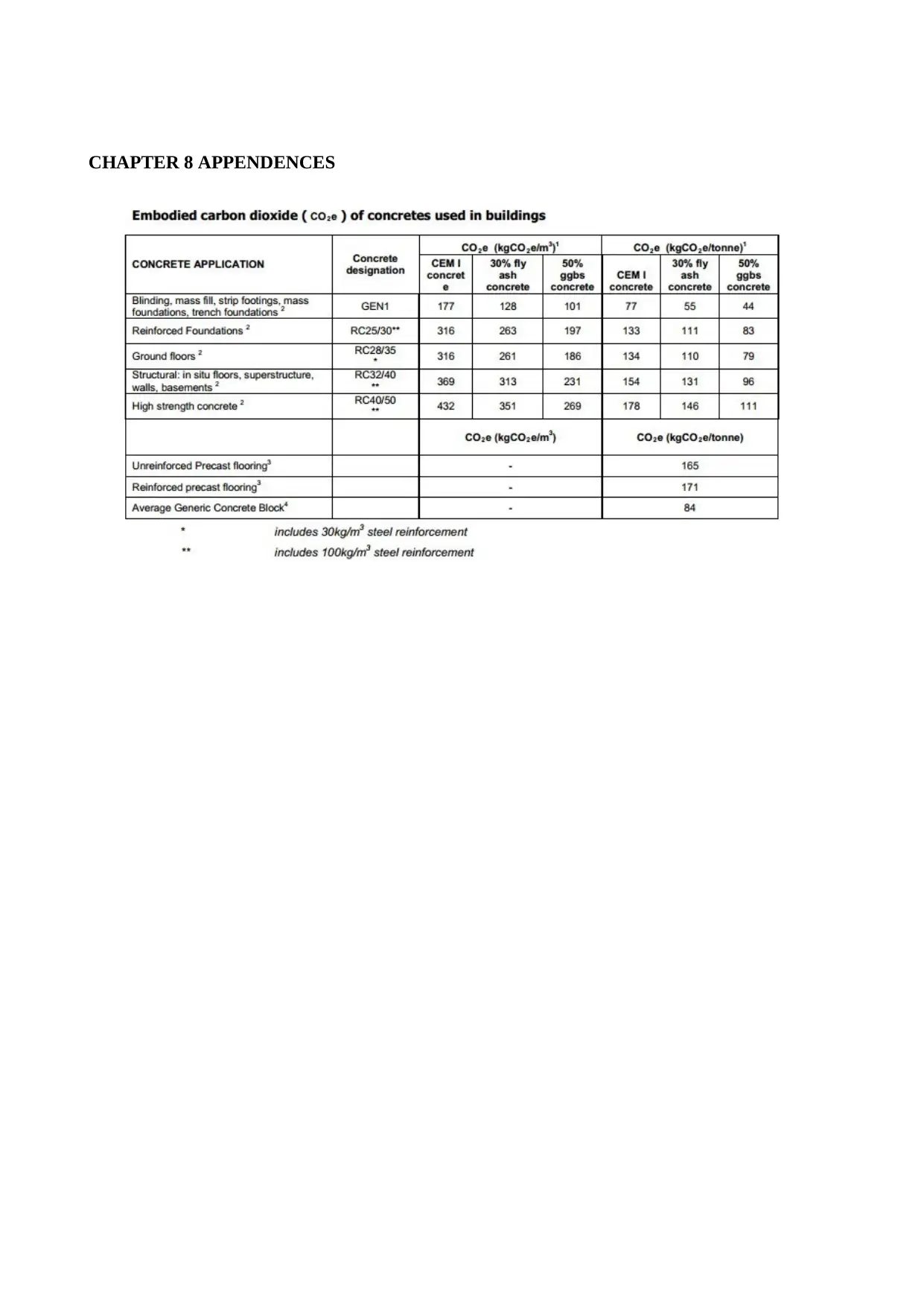
CHAPTER 8 APPENDENCES
Secure Best Marks with AI Grader
Need help grading? Try our AI Grader for instant feedback on your assignments.
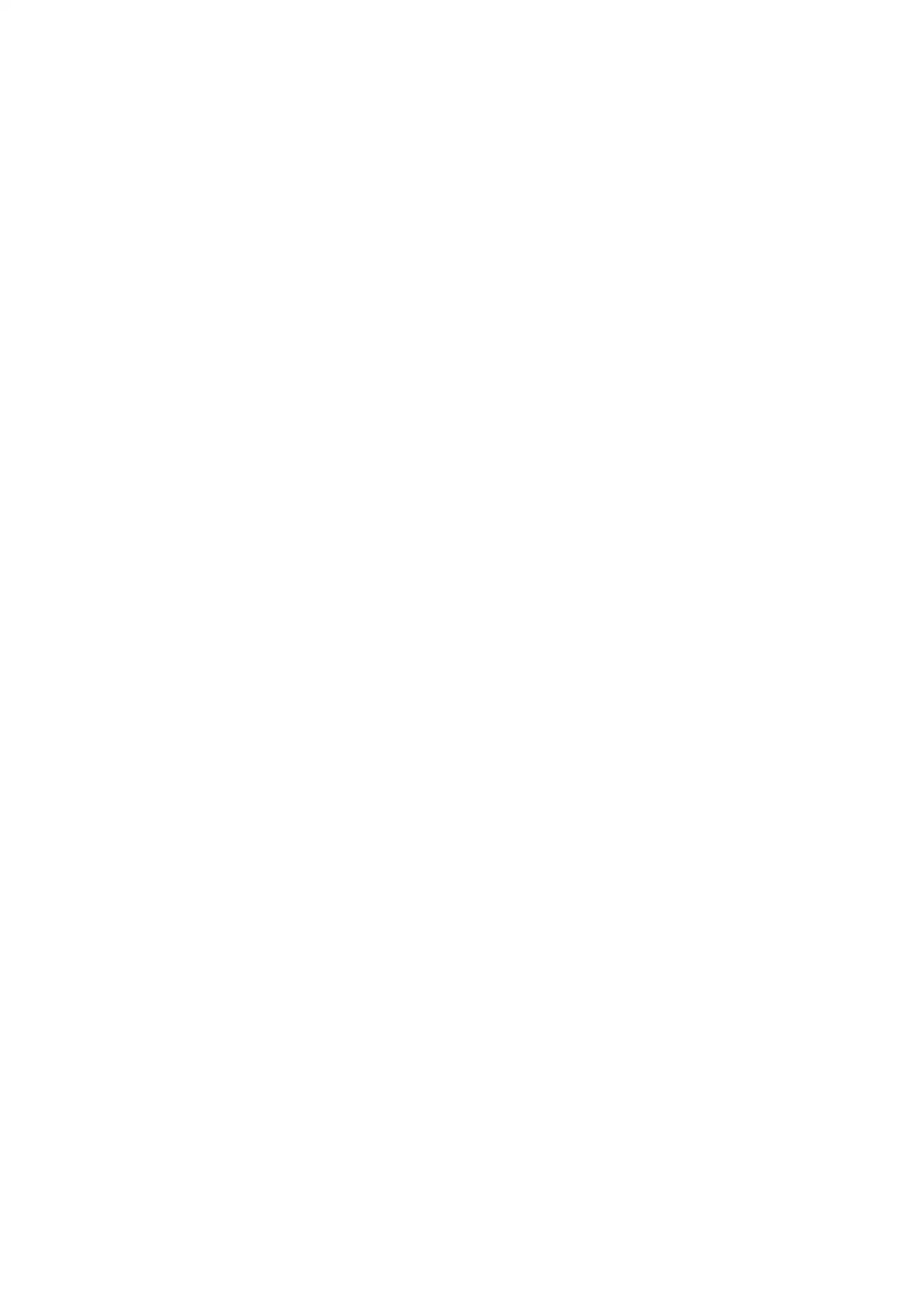
1 out of 35
Related Documents
Your All-in-One AI-Powered Toolkit for Academic Success.
+13062052269
info@desklib.com
Available 24*7 on WhatsApp / Email
![[object Object]](/_next/static/media/star-bottom.7253800d.svg)
Unlock your academic potential
© 2024 | Zucol Services PVT LTD | All rights reserved.





